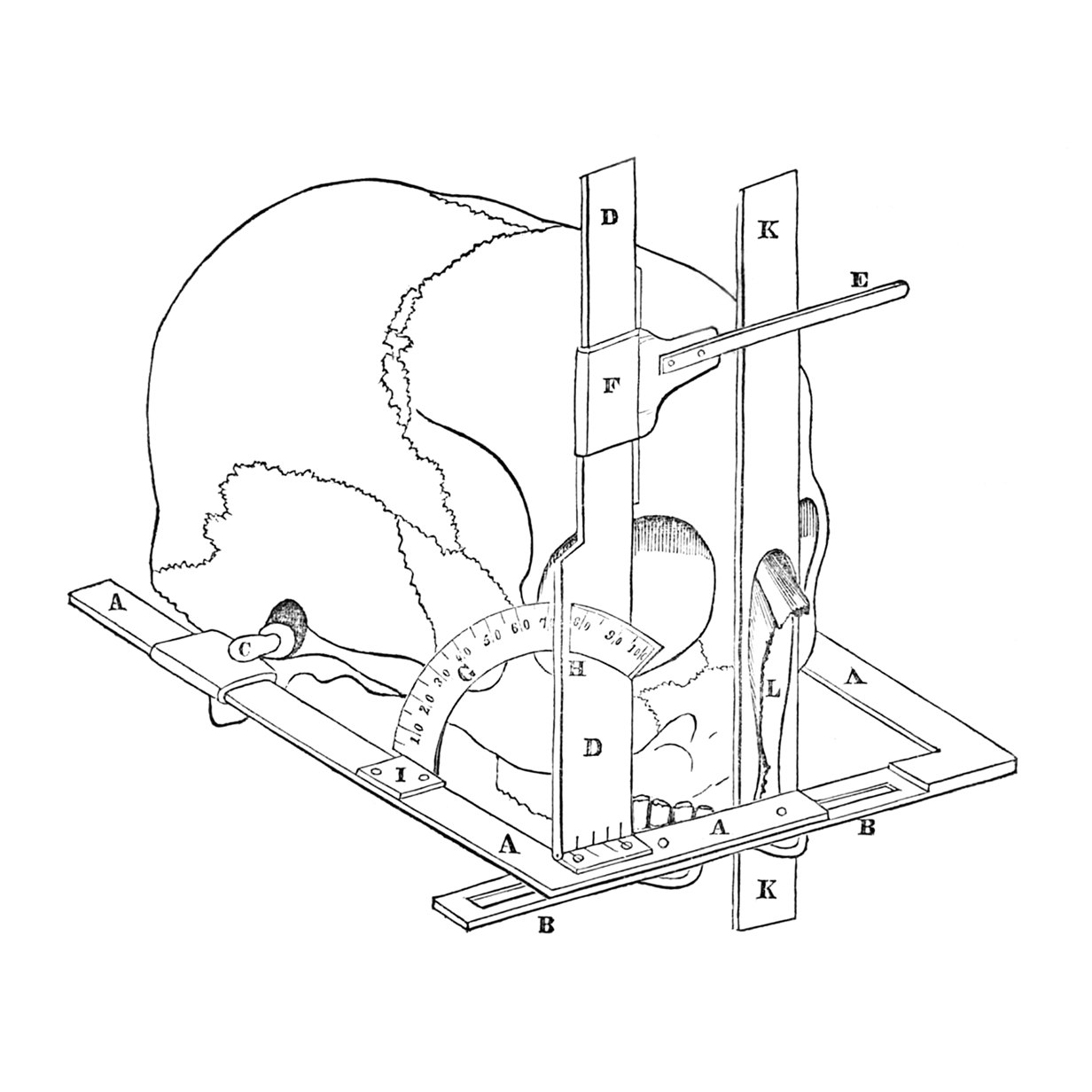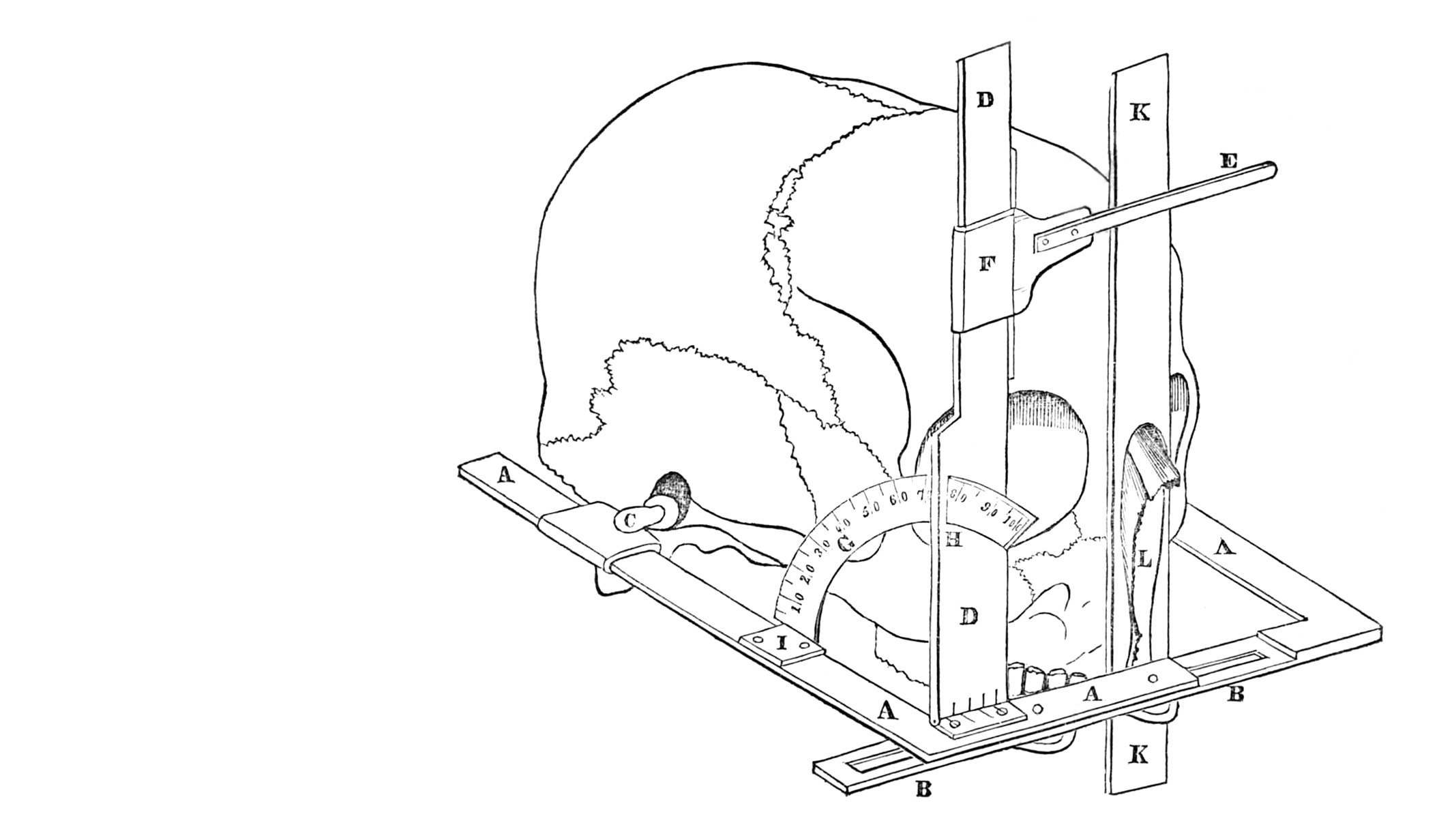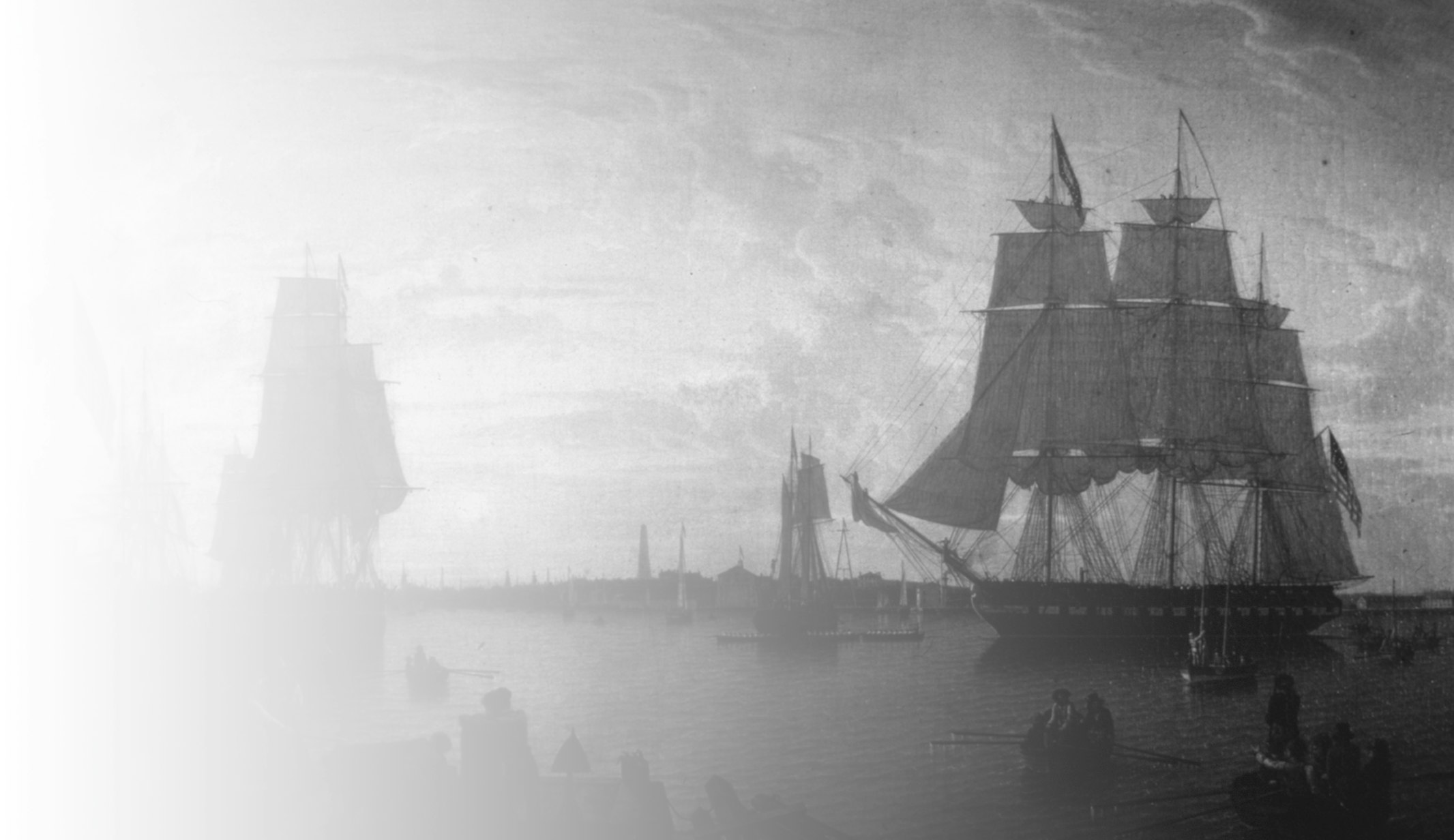
Financial Ties: Harvard and the Slavery Economy
Slavery may have ended—at least officially—in Massachusetts by 1783, but the ties between Harvard University and slavery continued. Beginning in the colonial period and continuing well into the 19th century, the University and its donors benefited from extensive financial ties to slavery.
For roughly a century, Harvard had operated as a lenderGo to footnote 152 detail and derived a substantial portion of its income from investments that included loans to Caribbean sugar planters, rum distillers, and plantation suppliers.Go to footnote 153 detail After 1830, the University shifted its investments into cotton manufacturing, before diversifying its portfolio to include real estate and railroad stocks—all industries that were, in this era, dependent on the labor of enslaved people and the expropriation of land.
Harvard’s financial ties to slavery also take the form of major gifts and bequests from donors who accumulated their wealth through slave trading, from the labor of enslaved people on plantations in the Caribbean islands and in the American South, and from the Northern textile manufacturing industry, supplied with cotton grown by enslaved people held in bondage.
New England and Caribbean Slavery
Harvard’s financial ties to slavery are multifaceted, and the economic links between colonial New England and the Caribbean provide critical context to understand such entanglements. Trade between New England and the West Indies proved so essential to both regions that one 17th-century observer declared Boston “the mart town of the West Indies.”Go to footnote 154 detail As early as 1667 the governor of the English colony of Barbados acknowledged that “these colonies cannot in peace prosper, or in war subsist, without a correspondence with” the New England colonies.Go to footnote 155 detail

While large-scale plantation slavery never took root in New England, for more than a century, Boston merchants played an essential role in sustaining the sugar plantation economy of the Caribbean; many of those same merchants were important players in Harvard’s early history. New England ships carried enslaved people and critical supplies to the Caribbean islands. They brought back slave-produced commodities like sugar and molasses, most of which was then re-exported throughout the British empire.Go to footnote 744 detail As early as the 1630s there were already more than 20 ships plying trade between New England and the British Caribbean.Go to footnote 156 detail As Edmund Burke observed in 1757, New Englanders became “carriers for all the colonies of North America and the West-Indies, and even for some parts of Europe. They may be considered in this respect as the Dutch of America.”Go to footnote 157 detail
Here, too, we begin with Governor John Winthrop. As the historian Wendy Warren has observed, “To understand New England not only by the labor done within its colonies but even more by the commodities that came and went is to understand New England as John Winthrop did, by its place in the world.”Go to footnote 158 detail Winthrop saw the region’s profitable trade with the West Indies, in particular, as a gift of God for the benefit both of the Massachusetts Bay Colony’s economy and its reputation:
[I]t pleased the Lord to open to us a trade with Barbados and other Islands in the West Indies, which as it proved gainful, so the commodities we had in exchange there for our cattle and provisions, as sugar, cotton, tobacco, and indigo, were a good help to discharge our engagements in England. And this summer there was great a drouth [drought], as their potatoes and corn, etc., were burnt up; and divers London ships which rode there were so short of provisions as, if our vessels had not supplied them, they could not have returned home; which was an observable providence, that whereas many of the London seamen were wont to despise New England as a poor, barren country, should now be relieved by our plenty.Go to footnote 159 detail

Timber was of particular importance to New England merchants engaged in the triangle trade. Because ships could be built and rigged in New England using only the produce of the region’s forests, shipbuilding became a significant facet of its economy.Go to footnote 160 detail And with so much Atlantic trade focused on slave-grown commodities, Boston merchants soon became central to that industry as well. In 1700, Governor Richard Coote wrote that “more good vessels belong to Boston than to all Scotland and Ireland.”Go to footnote 161 detail Timber from New England was also used to build and rebuild the Caribbean’s sugar plantations, whose infrastructure required constant replacement: more than 75 hurricanes struck the region between 1700 and 1775.Go to footnote 162 detail
Trading connections grew stronger throughout the 18th century, as Caribbean planters relied on New Englanders to provide the vital supplies required to maintain the plantation complex. New England’s fishing industries fed the West Indies sugar plantations, sending “refuse fish”—“salt burnt, spotted, rotten, and carelessly ordered”— to “the Charib-Islands, Barbadoes, Jamaica, &c. who feed their Negroes with it.”Go to footnote 163 detail Dried cod from New England was “the meat of all the Slaves in all the West Indies.”Go to footnote 164 detail

Importantly, these provisions imported from New England allowed West Indian planters to allocate far more land to sugar than would otherwise have been possible, enabling the system to grow. In Barbados, for example, after an unsuccessful attempt in the first decades of the 1600s to produce tobacco, planters turned to sugar as their primary crop; by the 1670s, Barbados produced 65 percent of the sugar sold in England.Go to footnote 165 detail Initially, sugar was a scarce commodity and commanded very high prices in European markets. In 1647, at which time about half of Barbados’s arable land was used for sugar, Massachusetts Governor John Winthrop received a letter stating that planters in the island were “so intent upon planting sugar that they had rather buy foode at very deare rates than produce it by labour, soe infinite is the profitt of sugar workes once accomplished.”Go to footnote 166 detail As other colonies followed Barbados into the market, however, supply increased and prices fell sharply.Go to footnote 167 detail To remain profitable, planters were forced to devote an ever-greater percentage of land to the crop. By 1767, the share of Barbadian land producing sugar “had risen to 80 percent, which meant that virtually all land useful for agriculture of any kind was devoted to this one crop.”Go to footnote 168 detail
As the amount of land dedicated to sugar production increased, so too did the number of enslaved laborers needed to work it. According to one estimate, the population in the mid-18th century across the Caribbean encompassed approximately 725,000 enslaved people and just over 250,000 whites. In the English colonies to which New England was most closely tied the divide was even more extreme.Go to footnote 169 detail

In short, New England merchants provided Caribbean sugar plantations with vital supplies, which enabled planters to remain profitable and expand the brutal business of slavery far beyond anything they could have otherwise sustained. In return, New Englanders acquired capital and slave-produced goods that were essential to their trade throughout in the Atlantic world. This cycle was New England’s economic bedrock. In 1783, John Adams (AB 1755) wrote: “The Commerce of the West India Islands, is a Part of the American System of Commerce. They can neither do without Us nor We without them.”Go to footnote 170 detail
Harvard Affiliates, Slavery, and the Slave Trade in the Colonial Era
It is not possible to document here all the many gifts that Harvard received from donors whose wealth was tied up in Caribbean slavery and slave trading, both because of incomplete data and because the precise ways in which donors’ profits are connected to sugar production and Caribbean slavery are not always clear or easy to trace. Certain examples stand out, however, and these notable bequests, which proved critical to Harvard’s growth and the establishment of its reputation as a prestigious university, warrant specific mention.
Isaac Royall Jr.
Perhaps the most well-known gift to Harvard by a donor involved in slavery is the bequest of Isaac Royall Jr., whose family’s sugar plantation on the Caribbean island of Antigua furnished the wealth that endowed the Royall Professorship of Law, Harvard’s first chair in law.Go to footnote 172 detail The plantation proceeds also allowed the Royalls to purchase their Medford, Massachusetts, estate, now a museum and historical site, where Isaac Royall Jr. enslaved at least 60 individuals.Go to footnote 173 detail
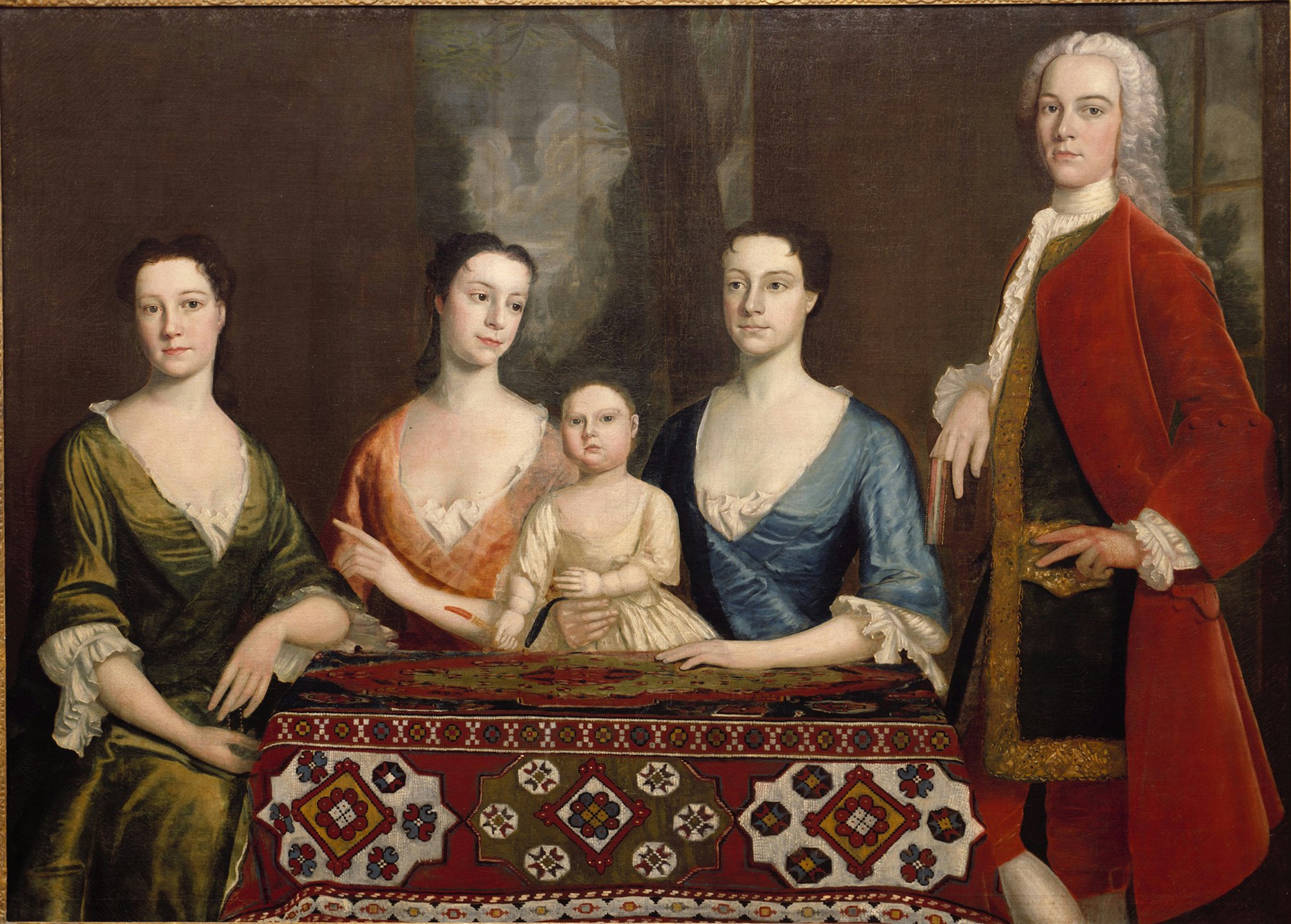
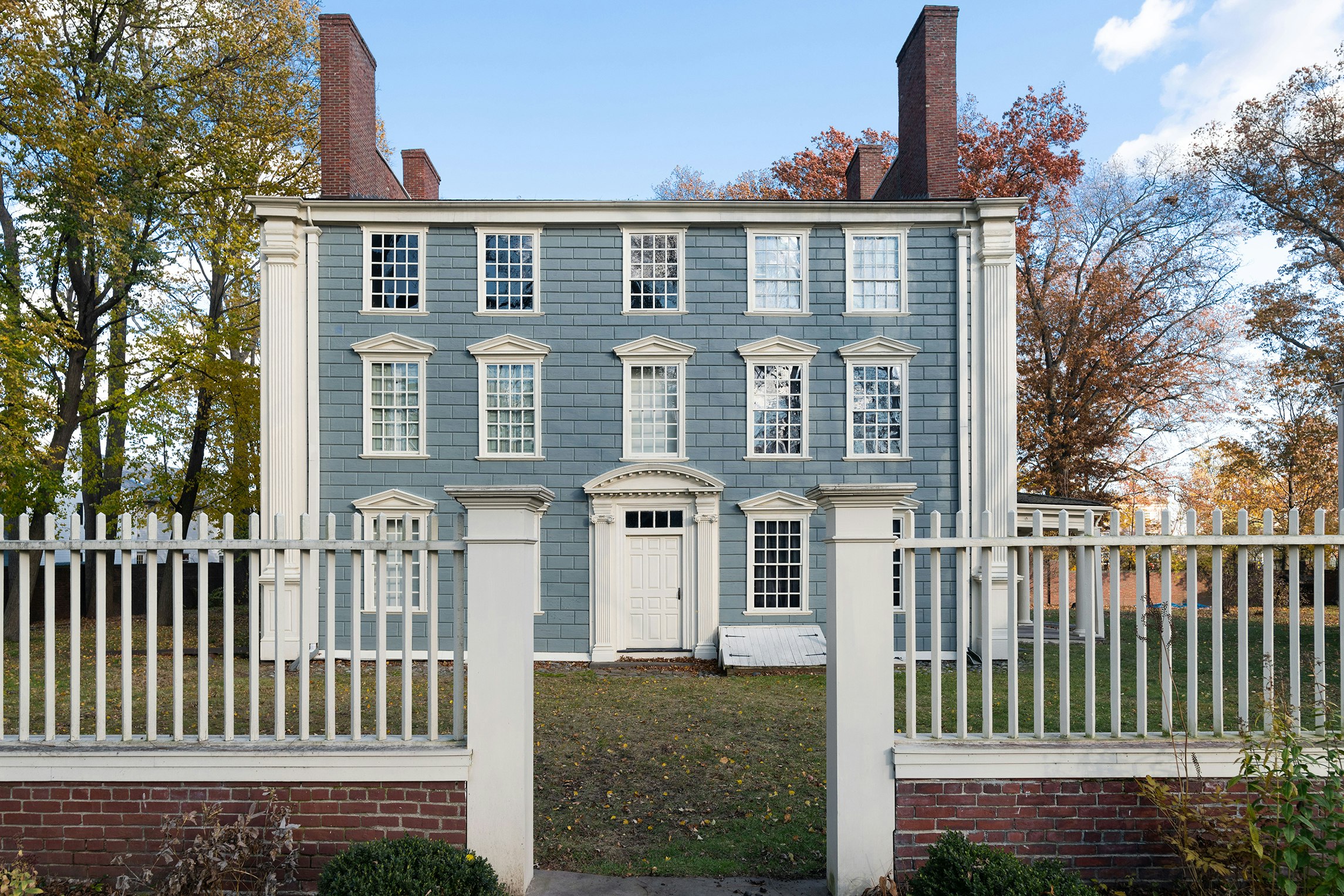
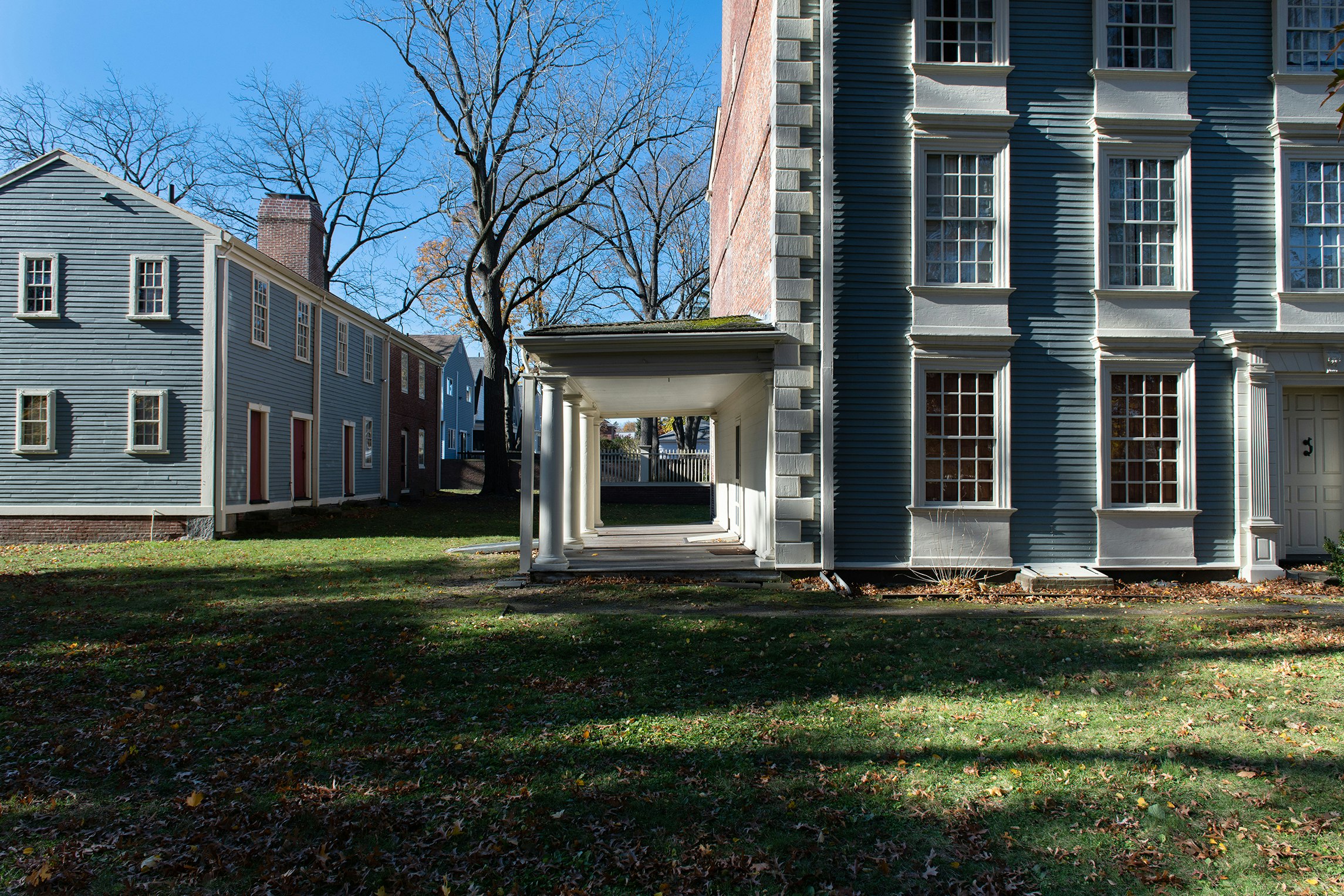



Yet the Royall’s wealth and Harvard’s first professorship of law are not the whole story. Isaac Royall Jr.’s sister, Penelope Royall Vassall, owned—among other enslaved people—Cuba Vassall and her children. Cuba had been brought to Cambridge by Penelope and Isaac’s father, who left Cuba to Penelope when he died. Meanwhile, Penelope’s husband, Henry Vassall, had brought another enslaved man, Tony Vassall, to Cambridge from Jamaica. Cuba and Tony married, and Cuba and their children were eventually sold to John Vassall, Henry’s nephew and a 1757 graduate of Harvard College. Among the children was Darby Vassall, who is a remarkable figure in his own right: an important player in Boston’s free Black community and an early activist for Black rights, his life and activism help to illustrate a critically important theme embedded in this report: Black resilience, agency, and achievement in the face of persistent discrimination.Go to footnote 174 detail
Samuel Winthrop
The Royalls were just one of many families whose slavery-begotten wealth supported Harvard, both before and long after Isaac Jr.’s bequest.Go to footnote 175 detail
In 1645, George Downing (AB 1642), a nephew of Governor John Winthrop and former tutor at Harvard (ca. 1643–1646), toured the British West Indies and delivered sermons in many of the islands’ churches. As he headed home to England, he penned a letter to his cousin John Winthrop Jr. encouraging him to migrate to the West Indies to make his fortune growing cash crops with enslaved labor:
[Colonists in Barbados] have bought this year no lesse than a thousand Negroes; and the more they buie, the better able they are to buye, for in a year and a halfe they will earne (with gods blessing) as much as they cost.Go to footnote 176 detail
Downing went on to explain that “Negroes (the life of this place)” were far better than “New England servants” to work West Indian plantations, as white colonists were “noon of the fittest for those parts.”Go to footnote 177 detail
John Jr. did not take Downing’s advice, but his younger brother Samuel Winthrop, the governor’s youngest son, did, dropping out of Harvard in 1645 and making his way first to Tenerife, in the Canary Islands, and, a year later, to the West Indies. Samuel became one of the first large-scale sugar producers in the British West Indies, eventually owning the rights to one quarter of the island of BarbudaGo to footnote 178 detail as well as a sugar plantation on Antigua where dozens of enslaved people labored to produce tens of thousands of pounds of sugar a year for export to New England and Europe.Go to footnote 179 detail He also served as the deputy governor of Antigua from 1667 to 1669.Go to footnote 180 detail Winthorpes Bay on the north side of the island memorializes the prominence of Samuel and his descendants in its early colonial history.Go to footnote 181 detail
Although Samuel never returned to New England, he remained deeply connected to the region, and to Harvard in particular. Before leaving Massachusetts Bay in 1645, Samuel, Downing, and two other Harvard graduates had jointly gifted land to the University—the first donation of property by alumni. The parcel, which was planted with apple trees and came to be known as the Fellows Orchard, is today the site of Widener Library.Go to footnote 182 detail
In an early letter to his father, the governor, Samuel asked to be remembered to family members and to “our most esteemed President, Henry Dunster.”Go to footnote 183 detail Many years later, Samuel would send four of his sons to New England to be educated with the express purpose of eventually enrolling them at Harvard.Go to footnote 184 detail In correspondence with his brother John Jr., then the governor of Connecticut, Samuel asked for help getting his sons admitted to the College.Go to footnote 185 detail Ultimately, he could not see these plans through: in 1667, after a French attack on Antigua ruined his plantation and decimated his enslaved labor force, Samuel wrote, “it is now all I have left besides my land & 12 working negroes, wth whoos hard labor I shall not be able to keep my Sonnes in New England.”Go to footnote 186 detail Despite this setback Samuel’s finances eventually recovered, and he died one of the wealthiest men in Antigua.Go to footnote 187 detail

Harvard Affiliates, Slavery, and the Slave Trade into the 19th Century
Harvard continued to benefit financially from the proceeds of enslaved labor well beyond the end of slavery in Massachusetts. During the first half of the 19th century, more than a third of the money donated or promised to Harvard by private individuals came from just five men who made their fortunes from slavery and slave-produced commodities.Go to footnote 188 detail Four of these men were directly involved in slavery or the slave trade, while the fifth—Peter C. Brooks—became the wealthiest man in New England by insuring New England’s merchant ships.Go to footnote 189 detail
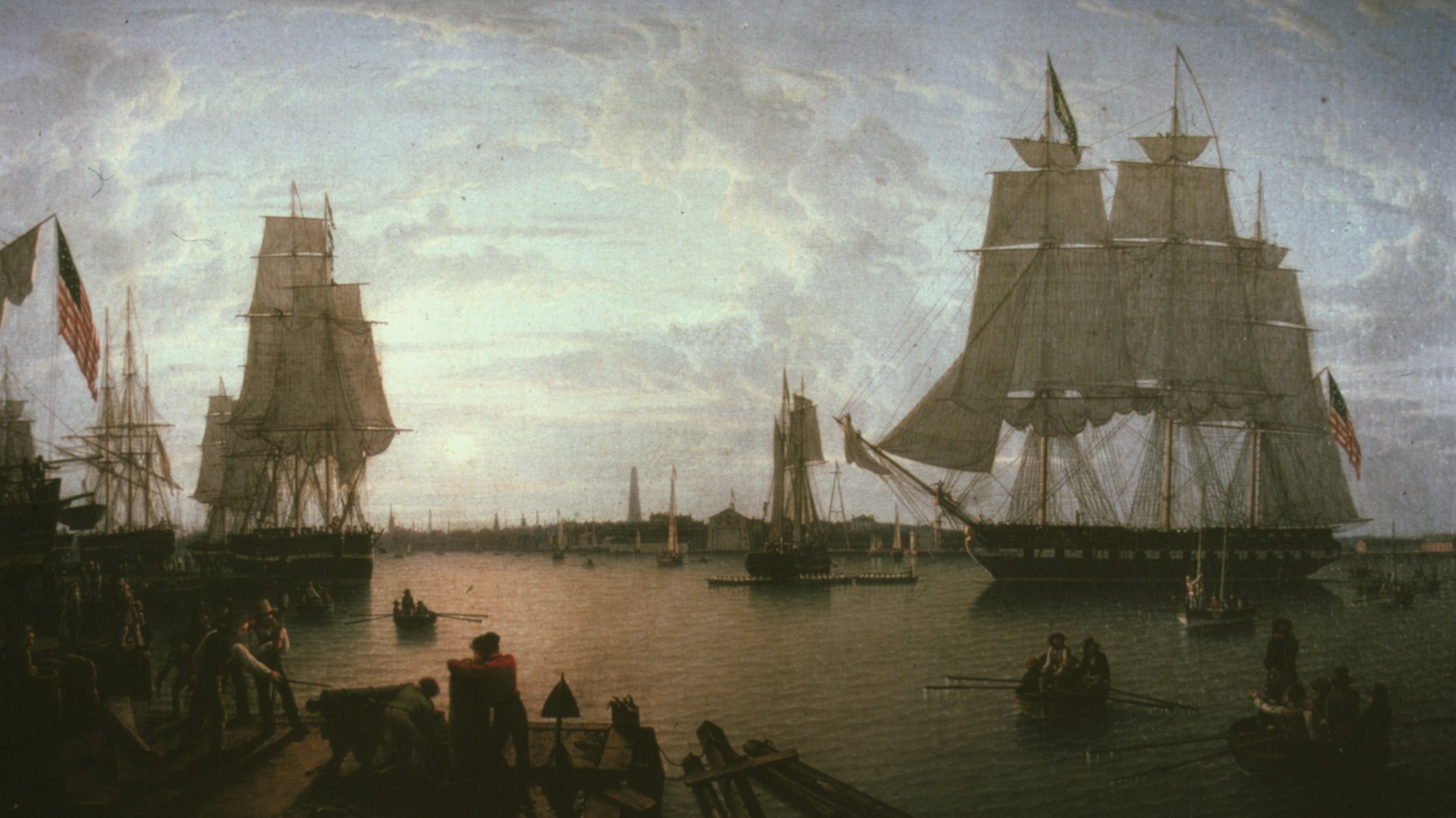
James Perkins bequeathed $20,000 to Harvard for the Perkins Professorship of Astronomy and Mathematics,Go to footnote 190 detail which the University created in 1842; his business, Perkins and Company, pursued a global strategy that included Caribbean slave trading, western land speculation, and opium trading in China.Go to footnote 191 detail Perkins and other members of his extended family are also integral to Harvard in other ways: they played a central role in the creation of Massachusetts General Hospital (MGH), and the Perkins Room in Massachusetts Hall—the primary conference room used by Harvard’s president and other senior leaders—is named for a descendant of this family.
Benjamin Bussey, a sugar, coffee, and cotton merchant, left Harvard an estate valued at $320,000 to be divided among the Divinity School, the Law School, and a school for agriculture. Today, the Arnold Arboretum is located on Bussey’s former estate in Jamaica Plain.Go to footnote 192 detail (By the time Harvard received this bequest, the net value of the trust had increased to roughly $400,000.Go to footnote 193 detail)
John McLean, another merchant, endowed the McLean Professorship of Ancient and Modern History in 1834 and supported Massachusetts General Hospital’s department for the care of the insane, the forerunner of McLean Hospital.Go to footnote 194 detail
Finally, Abbott Lawrence, who owned and operated cotton textile factories in Massachusetts along with a trading firm that marketed and distributed the products of his mills, donated $50,000 in 1847—followed by an additional $50,000 at his death in 1855.Go to footnote 743 detail These gifts established the Lawrence Scientific School, the institutional predecessor of the Graduate School of Applied Science that would also encompass Bussey’s agriculture school. The Lawrence Scientific School’s most eminent faculty member would be Louis Agassiz, recruited on the recommendation of Lawrence, who also personally paid Agassiz’s salary for a time.Go to footnote 195 detail Eventually, these institutions would evolve into today’s John A. Paulson School of Engineering and Applied Sciences.Go to footnote 196 detail
These donors, among other significant benefactors, are discussed in more detail in the sections that follow. While not comprehensive, these examples illustrate the multifaceted ties between Harvard’s major donors and slavery, the slave trade, and the trade in slave-produced goods.
The Perkins Brothers: James, Thomas Handasyd, and Samuel Gardner
When Thomas Nelson Perkins died at his home on October 7, 1937, his friends and colleagues commemorated his contributions as a “servant of Harvard and a leader among Harvard men.”Go to footnote 197 detail Perkins, a graduate of the College (1891) and the Law School (1894), served as a fellow for 30 years (1905–1924 and 1926–1937). He was a prominent lawyer and statesman whose memory would be enshrined “at the very heart and center of the University he loved and served.”Go to footnote 198 detail The Perkins Room in Massachusetts Hall, for use by the president and senior leaders of the University, was inaugurated on January 6, 1941, in his honor.Go to footnote 199 detail
Thomas Nelson Perkins was a scion of the wealthy Perkins family, which had, at the time of his death, supported the University for more than a century. The family’s wealth originated in the slave economy of the American South and especially the Caribbean, where Thomas Nelson’s great-grandfather, Samuel Gardner Perkins,Go to footnote 200 detail and great uncles, James Perkins and Thomas Handasyd Perkins (Samuel Gardner’s brothers), began building their fortune as slave traders in St. Domingue (now Haiti).Go to footnote 201 detail These three Perkins brothers—James, Thomas Handasyd, and Samuel Gardner—were each significant Harvard donors in their own right, and they bequeathed their estates to descendants who became prominent leaders at the University, among them Elizabeth Cary Agassiz—the first president of Radcliffe College.Go to footnote 202 detail
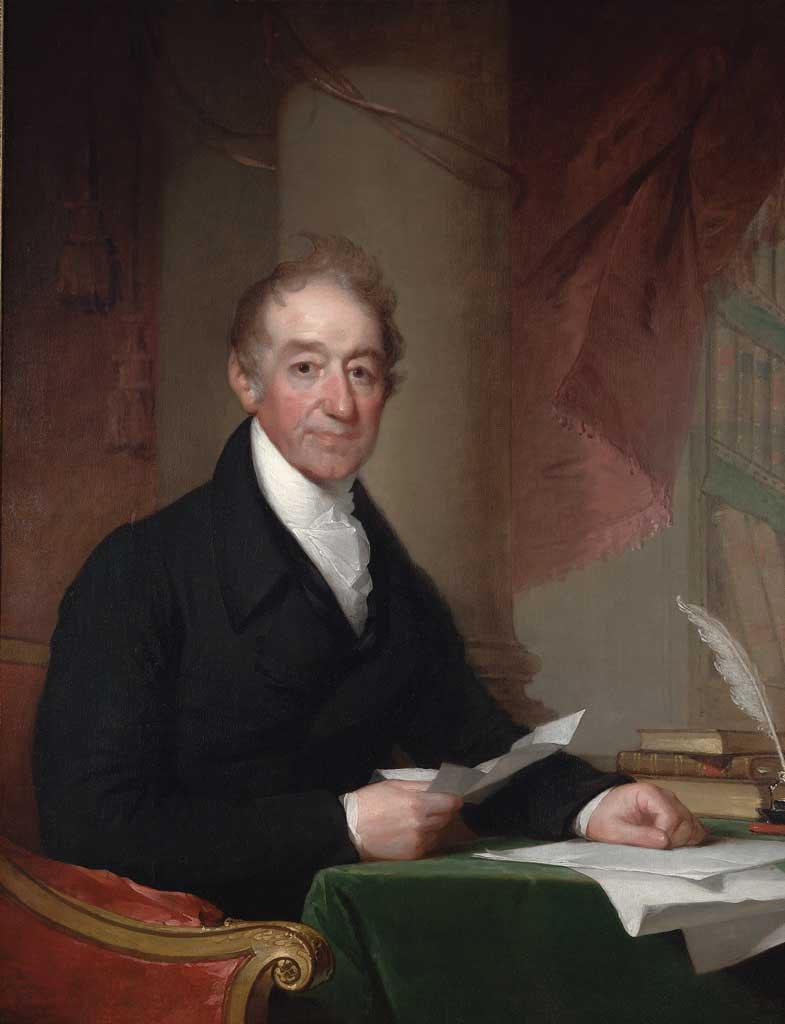
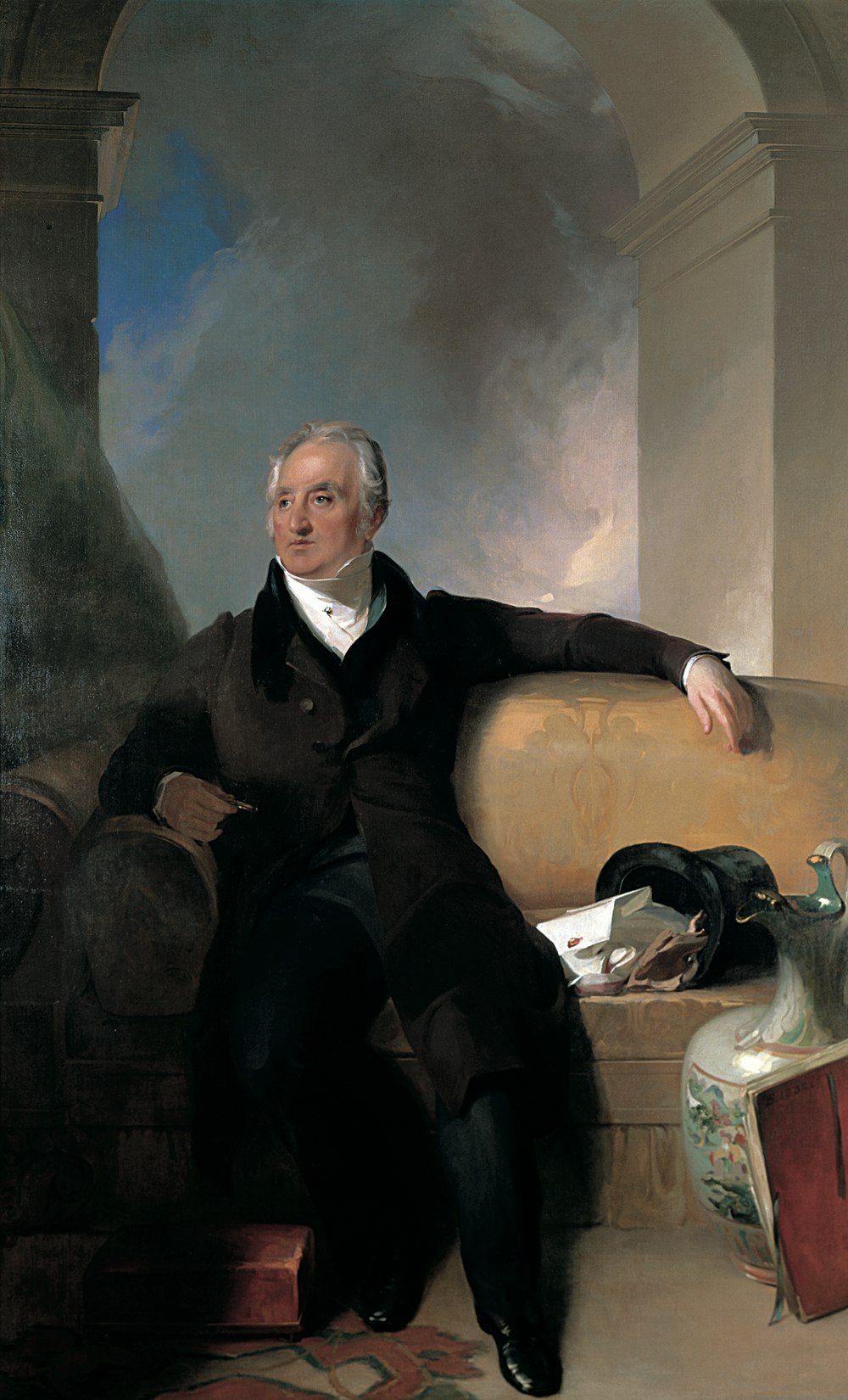


The Perkins brothers, active philanthropists, supported Harvard and several other important institutions. James bequeathed $20,000 to the University in 1822 to establish the Perkins Professorship in Astronomy and Mathematics, renamed the Perkins Professorship in Mathematics in 1906,Go to footnote 203 detail and served as a director of the effort to create the Theological School of Cambridge, now Harvard Divinity School, to which he and Thomas Handasyd both donated.Go to footnote 204 detail James and Thomas Handasyd also led the effort to create the Massachusetts General Hospital and served in turns as chair of trustees and vice president; Thomas also served as the hospital’s second president. As trustees, they were deeply involved in the initial fundraising effort, which raised nearly $150,000, and donated $5,000 each; their brother Samuel Gardner gave a further $100.Go to footnote 205 detail Thomas Handasyd and Samuel Gardner also supported the creation of the Massachusetts Professorship of Natural History at Harvard, now the Fisher Professorship in Natural History.Go to footnote 206 detail Beyond Harvard, the Perkins brothers helped to establish several prominent organizations in Greater Boston. James left his mansion on Pearl Street, valued at $40,000, to the Boston Athenaeum, one of the nation’s oldest independent libraries and cultural institutions.Go to footnote 207 detail And the Perkins School for the Blind in Watertown, Massachusetts, is named for the family, specifically Thomas Handasyd, who bequeathed his Boston mansion as a site for the school.Go to footnote 208 detail
The Perkins brothers’ parents and a grandfather were involved in the West Indies trade, so the brothers understood well, as did other New Englanders, the wealth that could be made in the Caribbean. The French colony of St. Domingue promised the opportunity to make a fortune.Go to footnote 209 detail
In the fall of 1782, long before the brothers became active as philanthropists, a 21-year-old James boarded the merchant ship Beaver to Cap Français, modern-day Cap Haitien in the north of Haiti.Go to footnote 210 detail The city was then a bustling metropolis and the capital of St. Domingue, the “pearl of the Antilles” in the French colonial imagination. It was built upon a rigorous racial hierarchy with a small white planter class at the top and enslaved Africans who worked the island’s sugarcane, coffee, and cotton fields at the base;Go to footnote 211 detail at the height of its economy in this period, St. Domingue imported as many as 40,000 enslaved men, women, and children per year by one estimate, due in part to the high mortality of enslaved people on the island’s sugar plantations.Go to footnote 212 detail Another source estimates a total of 700,000 enslaved people were imported to St. Domingue before the start of the Haitian Revolution in 1791, making it the single greatest exploiter of enslaved people in the Caribbean.Go to footnote 213 detail
James wrote letters from St. Domingue to family in New England, as did his wife, Sarah Paine Perkins, after she traveled to join him on the island. In November 1789, Sarah Perkins described her new home to a correspondent, lingering over a description of the “the sons and daughters of slav’ry,” whom she believed:
have their oppressions & even their wants—but their enjoyments are proportionate & I am very apt to believe that the Cup of Slavery is embittered with less gall than we are wont to imagine—for tho’ the task master may lift his whip against them, still their minds are unaffected & they appear as destitute of that smart which is keener than the adders sting (the anguish of the field) as their fellow mules. I have seen many of them who appeard to be susceptible of the greatest pleasure you can imagine & who were apparently discovering an enthusiastic enjoyment from their wild disorderly gambols, but never was once witness to any thing like that grief of heart, that affliction of the mind, which is the offspring of sensibility.Go to footnote 214 detail
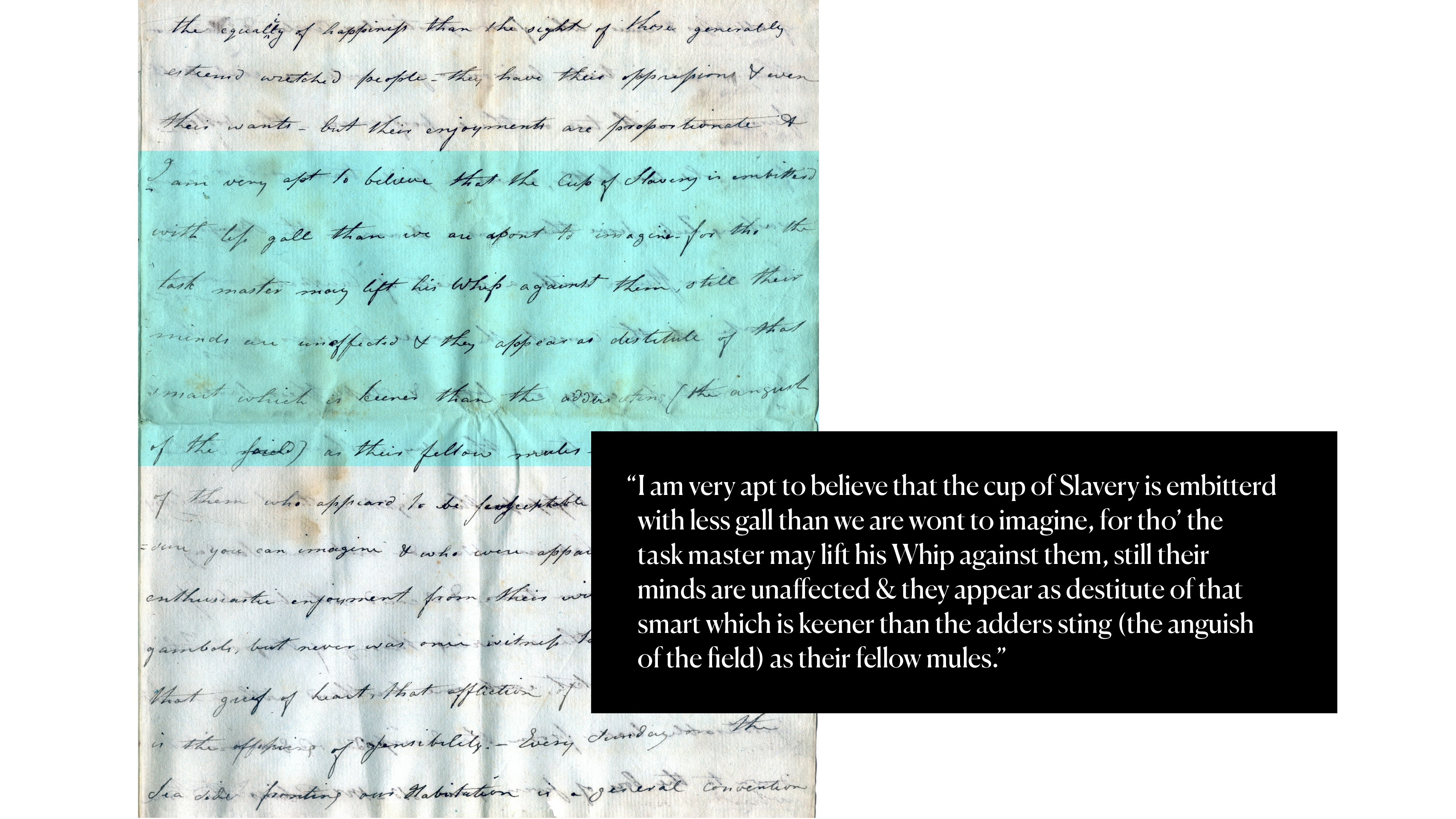
James joined the firm Wall, Tardy & Co as a commission agent for American merchants, purchasing colonial products made by enslaved people to ship to New England. When his younger brother Samuel Gardner turned 21, he, too, sailed for St. Domingue.Go to footnote 215 detail Samuel Gardner later recalled,
the flourishing state of trade and the prosperity of [St. Domingue’s] inhabitants were without a parallel perhaps in the world; for here there were no poor, I may say, either white or black,—for even among the latter those who were slaves were well taken care of, fed and clothed, and well sheltered by their masters, and those that were free were able to get a living without excess labor.Go to footnote 216 detail
The brothers entered into a partnership with Walter Burling to form Perkins, Burling & Company; the firm traded in the products of slave labor including sugar, molasses, coffee, and cocoa, as well as enslaved people themselves.Go to footnote 217 detail Thomas Handasyd managed the company’s business in Boston, while James and Samuel lived primarily in St. Domingue. On the island, they visited vessels in the Cap Français harbor to select enslaved women, men, and children for purchase, sometimes boarding ships to choose from among newly arrived Africans, and then selling them to slave owners on the island.Go to footnote 218 detail They also depended on ship captains and other third parties to sell enslaved captives throughout the Caribbean, especially in Havana, Cuba, and Kingston, Jamaica.Go to footnote 219 detail The Perkins’ business correspondence is extensive and documents commercial activities in Cuba, Curaçao, Guadeloupe, Jamaica, Martinique, Puerto Rico, St. Croix, and Trinidad.Go to footnote 220 detail Other merchants and slave traders sought letters of introduction to the brothers to gain access to the Perkins, Burling & Company network.Go to footnote 221 detail


In 1791, a rebellion began in the mountains of Cap Français that threatened the slave economy of St. Domingue and, by extension, the Perkins’ wealth.Go to footnote 222 detail In December of that year, a business partner wrote to James lamenting “your present situation” and informed him that “one Colonel Murray had in contemplation of sending a small vessel to assist in removing Mrs. Perkins and your family.”Go to footnote 223 detail James and his wife remained in St. Domingue, however, until the burning of Cap Français in 1792 led them and many of the colony’s prominent slaveholders to flee to Havana, New Orleans, Baltimore, and New England.Go to footnote 224 detail James took with him an enslaved man, Mousse,Go to footnote 225 detail who allegedly helped the family escape.Go to footnote 226 detail Although Perkins’s memoir states that the family freed Mousse, he remained attached to them in New England.Go to footnote 227 detail Samuel Gardner stayed behind.
James continued to administer the family business, remaining in regular contact with Samuel Gardner regarding activities in St. Domingue, even as the colony was engulfed in war. In May 1792, Samuel Gardner wrote:
the day after I purchased his Negroes there was not one for sale in the place. Indicott was obliged to wait some time & finally deposit in the hands of a Captain going with N- to Havana a sum of money considerably more than the value of 8 Slaves to get the privilege of carrying that number down in his vessel.Go to footnote 228 detail
As the situation deteriorated, Samuel Gardner kept James apprised of the difficulty both of acquiring and disposing of new cargoes of slaves.Go to footnote 229 detail By October 1792, he was reporting on the continued flight of the white population.Go to footnote 230 detail He returned to New England in 1793, married, and became a partner in his father-in-law’s mercantile house of Higginson & Co.Go to footnote 231 detail Samuel Gardner eventually entered the insurance industry and served as president of the Suffolk Insurance Company of Boston.Go to footnote 232 detail He would later recall his experience in St. Domingue as he advocated against emancipation in the United States, asking abolitionist women “to contemplate the horrors of degradation which must fall on their own sex throughout the Southern States” if they were to succeed and warning of “misery not only to the innocent whites, but misery and tenfold wretchedness to the slaves themselves; for this would as certainly follow a general rising of the blacks, or an immediate emancipation of them, as effect follows an operating cause.”Go to footnote 233 detail
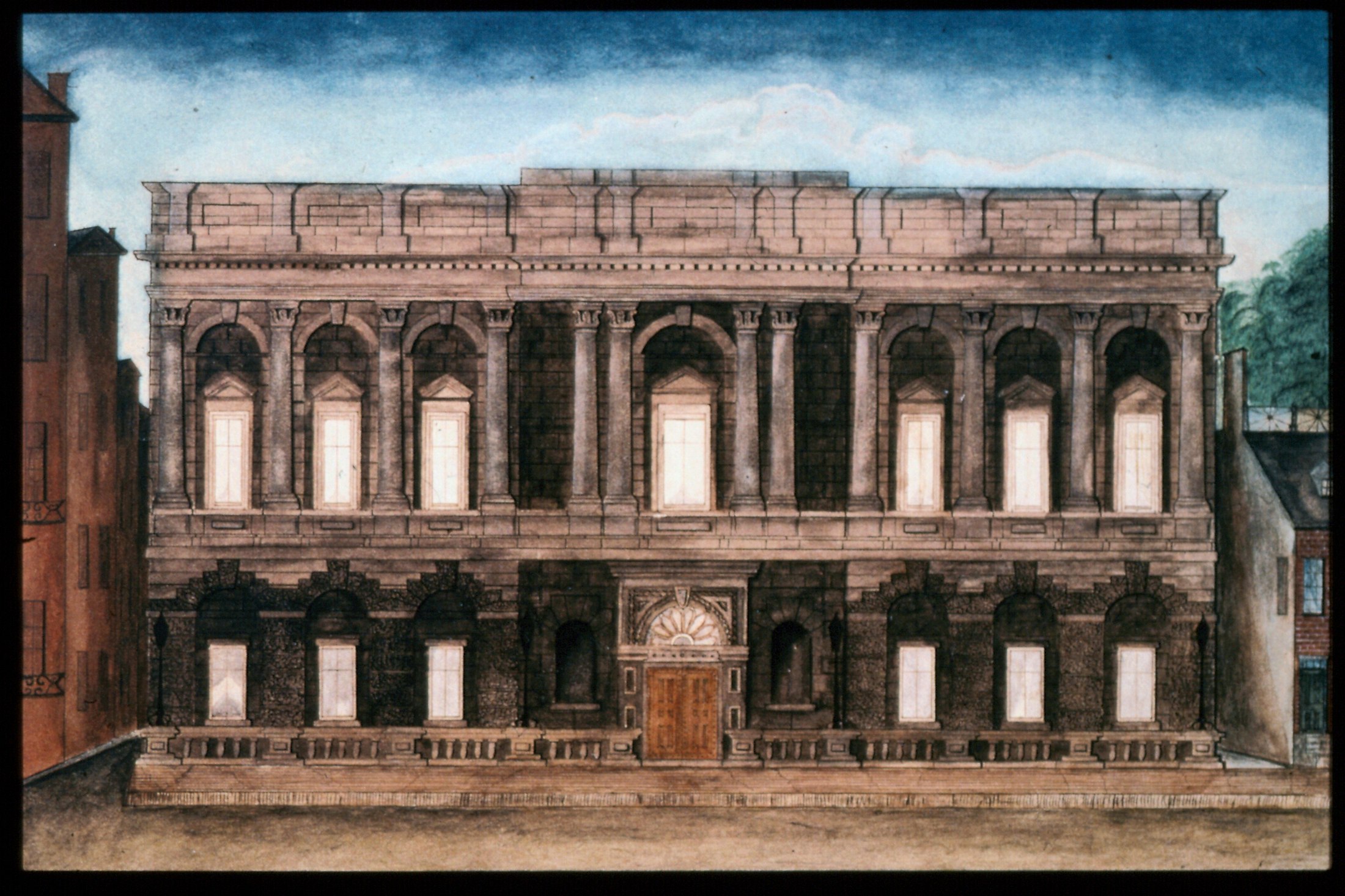
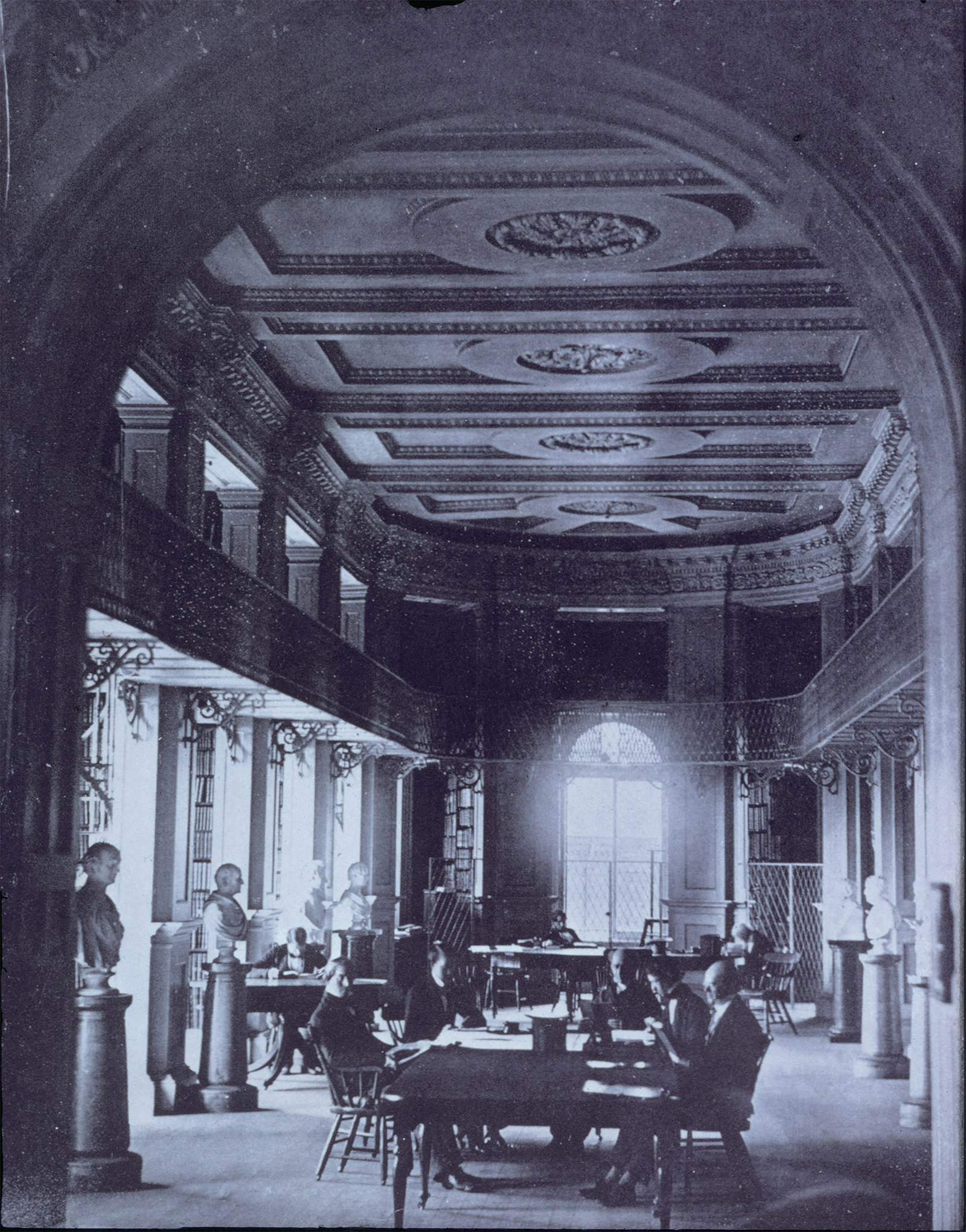
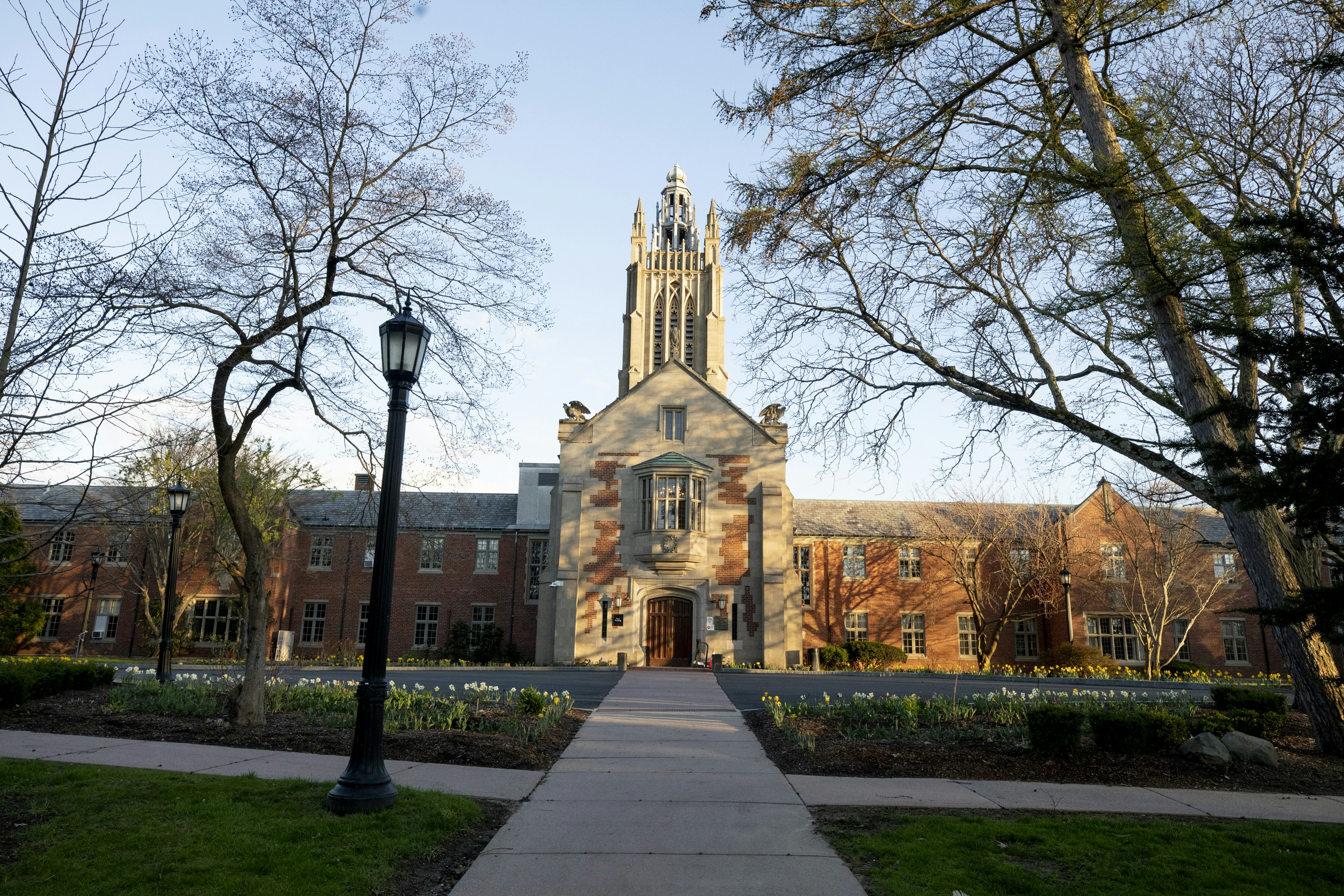



James and Thomas Handasyd redirected their primary business interest to the opium trade with ChinaGo to footnote 234 detail and sought to recast themselves as wealthy benefactors through generous gifts and bequests.Go to footnote 235 detail They were successful in this regard: when Harvard President Josiah Quincy (AB 1790; overseer, 1810–1829; president, 1829–1845) wrote his 1840 history of the University, he described James as among “benefactors of Harvard College … entitled to grateful remembrance.”Go to footnote 236 detail Quincy wrote of James:
His professional career was commenced in St. Domingo, where he established a commercial house, and conducted a prosperous business until he was compelled to leave the island by the insurrection of the colored population. At the hazard of his life, and with great loss of property, he escaped from St. Domingo, and returned to the United States. Soon after this event, he formed with his brother the commercial house of James and Thomas H. Perkins, which afterwards established a professional reputation second to none in North America. By the amount and discriminating nature of their bounty for the support of learning and the relief of suffering, and by their readiness to aid in every patriotic design, they have rendered their names synonymous with public spirit and benevolence.Go to footnote 237 detail
Israel Thorndike
In 1818, the Beverly, Massachusetts, merchant and slave trader Israel Thorndike paid $6,500 for a large collection of maps and books from the estate of Cristoph Daniel Ebeling, a professor of Greek and history. This collection, which Thorndike donated to Harvard,Go to footnote 238 detail contained “one of the most complete and valuable collections of works extant on American history” available at the time,”Go to footnote 239 detail and came to be the core of the Harvard Map Collection—the “most valuable single collection in existence.”Go to footnote 240 detail
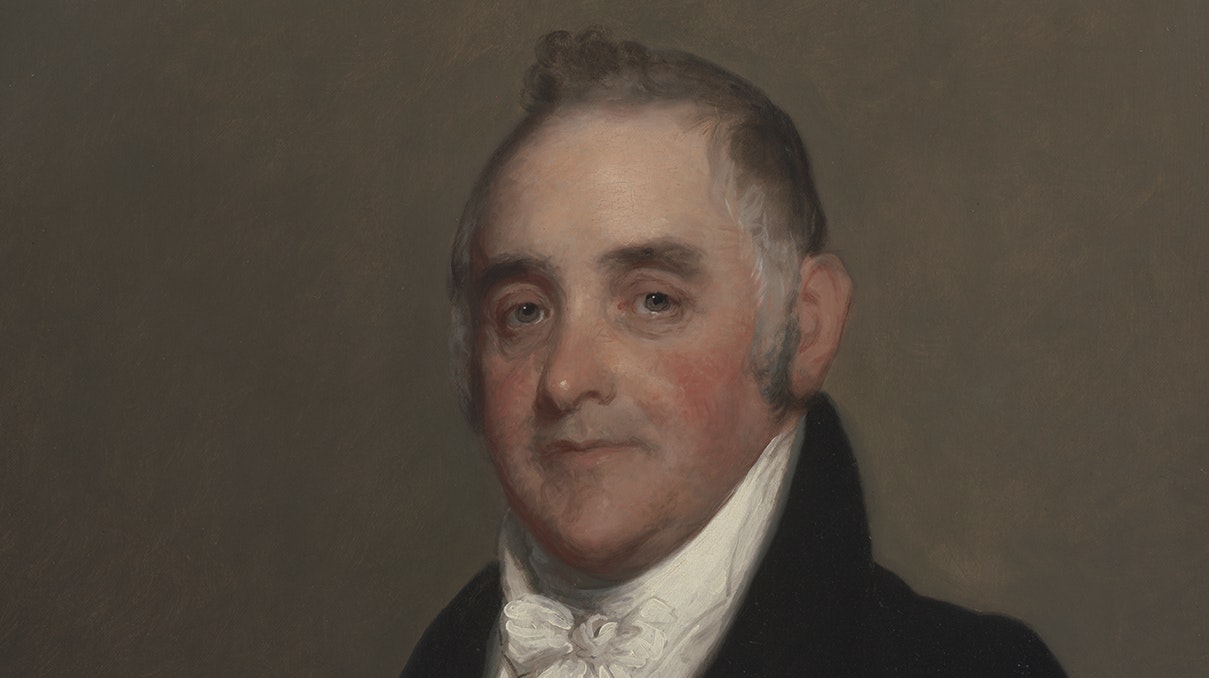
Besides the landmark Ebeling Map Collection gift, Thorndike, together with his son Israel Thorndike Jr., donated $2,100 to Massachusetts General Hospital.Go to footnote 241 detail In 1815, he served as vice president of A Society for the Promotion of Theological Education in Harvard University, which, with Thorndike’s support and that of other wealthy patrons—notably James Perkins, who also served as an officer in the society—established what is now Harvard Divinity School. Thorndike himself donated $500 to that fundraising effort and a further $500 “for the purchase of theological works.”Go to footnote 242 detail He also gave $500 in 1806 to support a natural history professorship and a further $100 in 1820 for a professorship of mineralogy and geology.Go to footnote 243 detail Like the Perkins brothers, Thorndike’s descendants were deeply involved at Harvard too. Augustus Thorndike was a renowned 20th century Harvard Medical School faculty member, and a professorship at the Massachusetts General Hospital bears the family name.Go to footnote 244 detail
Thorndike’s business interests also intersected with those of the Perkins brothers. He built his fortune primarily exporting flour and fish to the sugar plantations of the Caribbean and buying slave-produced goods like coffee, sugar, molasses, and rum to sell in US and European markets. Thorndike traded in enslaved women, men, and children as well, buying slaves in one port to sell at another.Go to footnote 245 detail In a 1791 letter to the captain of one of their ships, Thorndike and his business partnerGo to footnote 246 detail wrote the following orders:
Purchase from Five to Fourteen good Negroes, as the price may be, & lay in such food for them as is best suited to preserve their Health & proceed to the Havanna, in the island of Cuba[.] you be very carefull to keep them well secured at all times and on your arival you sell them for the most that can be obtained, & purchase as much Molasses as your Vessel will stow, leaving Room only sufficient to stow the goods you may purchase with your surplus cash, which you vest in Sugar, Cotton or HidesGo to footnote 247 detail
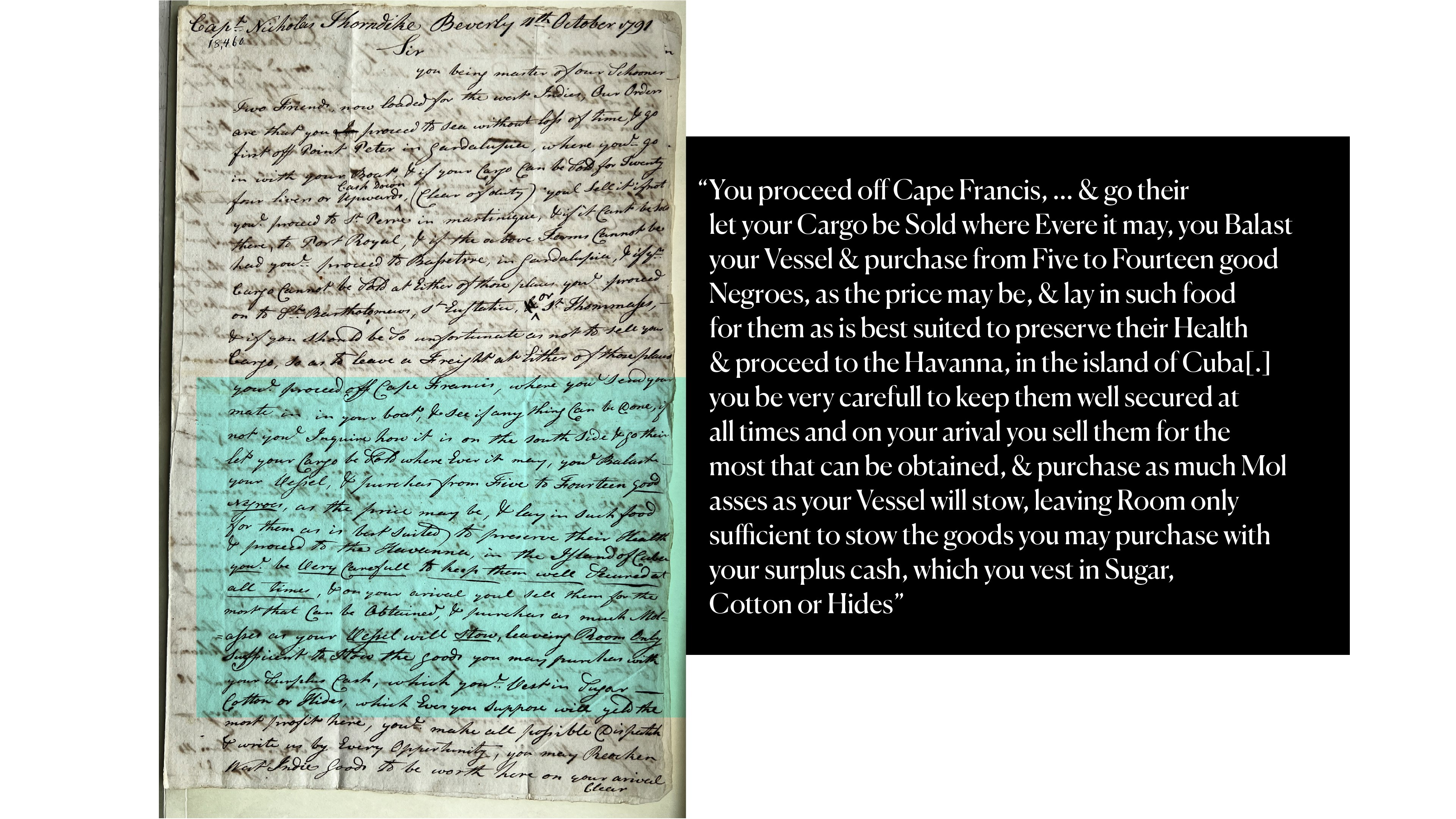
While such transactions may have been a relatively small part of Thorndike’s overall business dealings,Go to footnote 248 detail it is clear that he engaged in slave trading over the course of many years leading up to the Haitian revolution.Go to footnote 249 detail Thorndike ultimately shifted—like the Perkins brothers—to the China trade, as well as to investments in New England’s textile industry.Go to footnote 250 detail
Trade in Slave-Produced Goods
John McLean
In his 1840 The History of Harvard University, Josiah Quincy wrote that John McLean “disposed of his large estate in a spirit of general benevolence, equally useful, exemplary, and just.”Go to footnote 251 detail From an original bequest of $50,000, left in trust at the time of McLean’s death for the support of his widow, the University eventually received $25,000 to endow the McLean Professorship of Ancient and Modern History. Massachusetts General Hospital—the first teaching hospital associated with Harvard Medical School—also received nearly $120,000 from McLean’s estate.Go to footnote 252 detail This gift was monumental: more than a fifth of the total amount of bequests received by the institution in the four decades following its 1811 charter,Go to footnote 253 detail the gift was equivalent to eight years of the hospital’s annual operating expenses at mid-century.Go to footnote 254 detail For his generosity, the division of the hospital dedicated to the treatment of mental illness was renamed in McLean’s honor. McLean Hospital, now an independent Harvard-affiliated hospital in Belmont, Massachusetts, still bears his name today.Go to footnote 255 detail

McLean made his fortune in the slavery-entangled trade with the West Indies that powered the Massachusetts economy from the colony’s earliest days. According to Quincy, McLean “prosecuted trade with great skill and success, chiefly with the interior of New England and the West Indies.”Go to footnote 256 detail Like so many Massachusetts merchants, including his father,Go to footnote 257 detail he shipped lumber from New England to Caribbean plantations. He then purchased sugar produced by enslaved people to sell in Europe and the United States. Between 1793 and 1795 alone, McLean is listed as an owner of 10 ships registered in Boston and adjacent Charlestown.Go to footnote 258 detail A list of spoliation claims submitted to the federal government by US merchants seeking to recoup their losses on merchant voyages captured by the French in the 1790s notes McLean as an underwriter on eight separate voyages, including shipments of foodstuffs, dry goods, and wood products to the West Indies; cargos of slave-produced goods, including sugar, coffee, tobacco, and their derivatives, from the West Indies to the United States and Europe; and, in one case, a shipment of slave-produced goods from the American South to Europe.Go to footnote 259 detail
Benjamin Bussey
In his 1835 will, Benjamin Bussey explained at length his reasoning for leaving a significant portion of his wealth to Harvard University, namely his desire “to advance the prosperity and happiness of our common country.” He wrote:
In a nation whose government is held to be a government of laws, I deem it important to promote that branch of education which lies at the foundation of wise legislation and which tends to ensure a pure and uniform administration of justice and I have considered that in a country whose laws extend equal protection to all religious opinions, that education which tends to disseminate just and rational views on religious subjects is entitled to special patronage and support.Go to footnote 260 detail

Bussey left half of his estate to Harvard to support theological and legal education and the establishment of a school of agriculture, botany, and other natural sciences.Go to footnote 261 detail The net value of his bequest, when the University received it in 1861, was just over $400,000—enough to establish Bussey Professorships at Harvard Law School and Harvard Divinity School as well as the Bussey Institution on the property Bussey left to the University, now the Arnold Arboretum, in Jamaica Plain, Boston.Go to footnote 262 detail In recognition of these gifts, a marble bust of Bussey is displayed in Annenberg Hall, the freshman dining room in Memorial Hall.Go to footnote 263 detail The Harvard Portrait Collection also contains a likeness captured by the famed American portraitist Gilbert Stuart.Go to footnote 264 detail
In a brief handwritten memoir composed near the end of his life, Bussey emphasized his humble origins as the son of a poor New England farmer, his service as a quarter master during the American Revolution, and his work “night & day” to establish himself as a goldsmith in Massachusetts after the war. He devoted less than a paragraph, however, to the period during which he amassed his fortune: he only briefly noted that he “supplied many traders in Prov[idence], New Port, & all ye country round”Go to footnote 265 detail and did not mention that many of the traders he supplied would have been engaged in the West Indies trade. At this time, the slave trade in Rhode Island—long an important center—was approaching its peak.Go to footnote 738 detail
In 1790, Bussey tells us, he moved to Boston and worked “as I ‘d in Dedham, day & night; did a large bus[iness]; owned several ships; engaged in many kinds of merc[antile] adventures” for “abt 15 years.”Go to footnote 266 detail Other sources detail these “adventures:” records of spoliation claims include multiple vessels owned by Bussey and voyages he underwrote. More than half of these voyages originated in the United States and were bound for the Caribbean with supplies that New England merchants had long provided to island plantations.Go to footnote 267 detail
Bussey also provisioned the plantation economy in North America. As early as 1789, he invested in a voyage carrying supplies to New Orleans, including flour, building materials, farming implements, and hundreds of yards of “toe cloth”—a rough fabric routinely used to make clothing and bedding for enslaved people. The ship returned north with a cargo of tobacco.Go to footnote 268 detail By the early 19th century, Bussey’s business ties spanned the American South,Go to footnote 269 detail necessitating that Bussey have representatives on the ground. In 1802, his son-in-law traveled to Savannah on his behalf to collect on numerous debts:Go to footnote 270 detail “Messrs Chapman & Weston” were expected to pay in tobacco,Go to footnote 271 detail while Ebenezer Jenckes of Louisville, Kentucky, was expected to remit payment in the form of cotton.Go to footnote 272 detail Such arrangements were typical, and Bussey often shipped such goods—produced by enslaved people in the West Indies and the American South—to Europe, where he sold them and purchased fabrics, dinnerware, and other goods for US markets.Go to footnote 273 detail
Bussey frequently did business with other Harvard donors, part of a tight-knit community of wealthy Boston merchants and businessmen with ties to the University. Among his French spoliations claims are merchant voyages underwritten or co-owned by Thomas Handasyd and James Perkins, Israel Thorndike, and John McLean, each discussed above.Go to footnote 274 detail Bussey also invested in the Lawrence Manufacturing Company, owned by Abbott Lawrence, discussed below.Go to footnote 275 detail And Bussey’s attorney, Samuel P. P. Fay (AM 1798; overseer, 1824–1852) is the namesake of Fay House, the principal administrative building of the former Radcliffe College—today the Radcliffe Institute for Advanced Study.Go to footnote 276 detail
During the latter decades of his life, Bussey’s focus shifted to business interests in New England. He owned property across the region, including extensive holdings along Boston’s waterfront that city officials repeatedly sought to acquire for city projects. This included land “bounding on ye Mill Creek_ South of Ann Street and North of the Town dock,”Go to footnote 277 detail part of what is now the Quincy Market complex, which Josiah Quincy, then mayor of Boston, purchased for the city in 1824.Go to footnote 278 detail At the time of his death in 1842, Bussey still owned large swaths of the city, a country estate in Roxbury (now Jamaica Plain), a woolen manufactory in Dedham, and extensive property in what is now Maine.Go to footnote 279 detail
After Bussey’s death, it fell to Quincy—now the president of Harvard—to thank Bussey’s widow on behalf of the Corporation.Go to footnote 280 detail Like his business dealings in life, Bussey’s final bequest illustrates not only the links between Harvard and economies of slavery, but also the close ties that bound the Massachusetts elite—merchants, businessmen, and politicians—to one another and to the University.
Edwin F. Atkins
Examples until this point all date to the era in which slavery was legal in the United States, if not in Massachusetts. Yet Harvard connections to slavery persisted even after the end of the Civil War.
In 1899, for example, the Boston-based sugar magnate Edwin F. Atkins granted $2,500 to the Harvard botanist Oakes Ames to begin research on the possible development of new, better strains of sugarcane through selection and breeding at the Atkins family’s Soledad Plantation in Cuba.Go to footnote 281 detail
Cuba had by the 1830s replaced St. Domingue (Haiti) as the most prominent slave economy of the Caribbean,Go to footnote 282 detail and the Atkins family had been exporting sugar and molasses from the island since 1838, some 30 years before the beginning of Cuba’s gradual abolition of slavery. In 1868, at the beginning of the Ten Years’ War, Cuban independence leaders declared emancipation, and enslaved people who fought on either side were granted their freedom, setting in motion a slow and halting path toward the end of slavery.Go to footnote 283 detail Meanwhile, during the war, American investors, including the Atkins family, extended credit to Cuban plantation owners. By the end of the 19th century, such investors had acquired most of the plantations in Cuba; Atkins, looking to expand into sugar production, acquired Soledad Plantation in 1884.Go to footnote 284 detail
Four years earlier, the Spanish government’s 1880 abolition law had established an eight-year period during which nominally free formerly enslaved people were labeled apprentices, or patrocinados, and compelled to continue working for their enslavers.Go to footnote 285 detail This system was, in effect, slavery by another name. In fact, before Atkins purchased Soledad, the plantation’s owners sent a bill of sale to his business partners that listed 177 patrocinados as slaves, despite their new legal status. When E. Atkins & Company officially acquired the plantation, it came with at least 95 formerly enslaved patrocinados.Go to footnote 287 detail
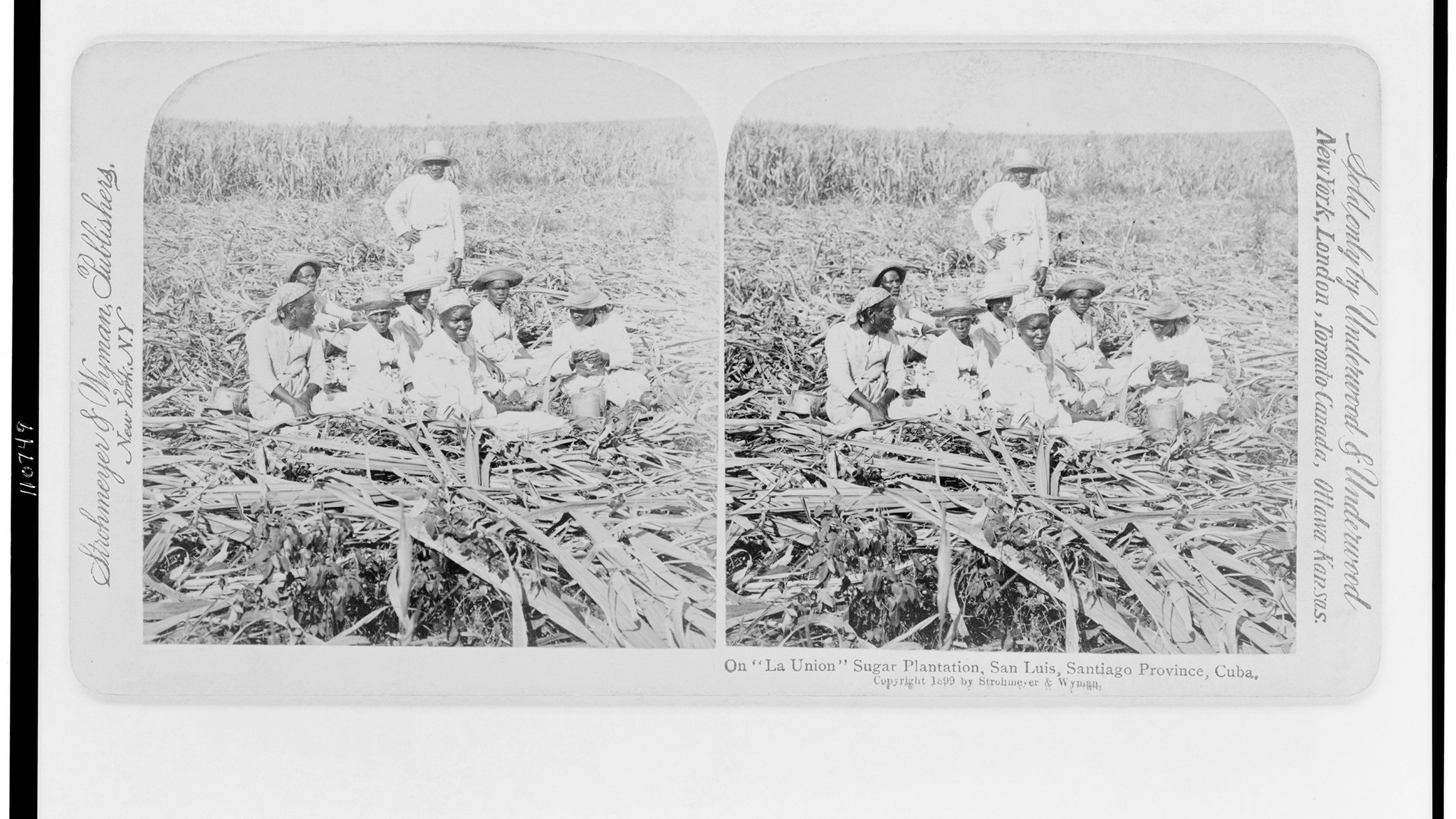
Edwin Atkins’s correspondence with his plantation manager immediately after he took possession reflects a preoccupation with reducing labor costs in order to compete with other producers.Go to footnote 288 detail They discuss strategies to retain control of the Black workers,Go to footnote 289 detail as well as the extraction of payment for releasing workers from indentured servitude, apparently including some who were already free by law.Go to footnote 290 detail By the end of the century, Atkins had expanded the estate from its initial 900 acres to 12,000 acres of land in the hills and mountains of Cienfuegos.Go to footnote 291 detail
A section of this plantation became a Harvard biological research station at the turn of the 20th century. In later years, scholars and students would test varieties of sugarcane on the property and develop new ways to eradicate diseases.Go to footnote 292 detail To provide sustained support for this work, Atkins presented to the University initial payments on an endowment fund which, between 1919 and 1925, would come to total nearly $200,000.Go to footnote 293 detail In 1932, Soledad officially became known as the Atkins Institution of the Arnold Arboretum, Harvard University.Go to footnote 294 detail Harvard’s involvement was suspended in 1961, in the wake of the Cuban revolution, and the site is now managed by the Cuban government as the Cienfuegos Botanical Garden.Go to footnote 295 detail
Southern Slavery and Northern Textile Manufacturing
Harvard’s ties to the Caribbean and to wealthy planters and traders is a critical part of the story of the University’s financial involvement with slavery, but it is not the whole story. With the development of industrial capitalism in the late 18th and early 19th centuries, the plantation economy evolved, and cotton began to take center stage. By the middle of the 19th century, as the historian Sven Beckert observed, cotton manufacturers and merchants in the United Kingdom “stood at the center of a world-spanning empire,” acquiring slave-produced cotton from the Americas for their mills and selling cotton products to “the most distant corners” of the globe.Go to footnote 296 detail New England and its vast textile mills followed, and Harvard affiliates’ deep connections to this lucrative industry—fed with cotton produced by enslaved people primarily in the American South—are another important part of the University’s story.
Abbott Lawrence
In his 1846–1847 annual report to the Board of Overseers, Harvard President Edward Everett shared a “plan of organization for an advanced school” to provide “systematic instruction in those branches of sciences which are more immediately connected with the great industrial interests of the country.” Disciplines of instruction included chemistry “in its various applications to the arts of life,” engineering, geology, and zoology.Go to footnote 297 detail The plan was approved in February 1847, but the University lacked the funds necessary to construct new buildings and hire relevant faculty.

This uncertainty quickly resolved: in June 1847, the Boston industrialist Abbott Lawrence announced his donation of $50,000 to “defray the expenditures” necessary for the Scientific School, including “the erection of suitable buildings … the purchase of apparatus, furniture,” as well as “comfortable support of the professors and other teachers employed.”Go to footnote 298 detail The new school would train Harvard students in “the practical sciences,” to prepare “engineers, … miners, machinists, and mechanics” for skilled employment in America’s rapidly industrializing economy.Go to footnote 299 detail Everett remarked that Lawrence’s “munificent donation” was at that time “the largest sum … ever bestowed on a place of education in this country, in one gift, by a living benefactor.”Go to footnote 300 detail The new scientific school was named in Lawrence’s honor and, upon his death in 1855, he bequeathed an additional $50,000 “for the further advancement of the said school.”Go to footnote 301 detail Today, Lawrence’s gifts support endowed professorships in the Lawrence Scientific School’s successor, the Paulson School of Engineering and Applied Sciences.

The founder and namesake of the town of Lawrence, Massachusetts, Lawrence was co-owner of the A & A Lawrence Company, which managed the Lawrence Textile Manufacturing Company, and president of both Atlantic Cotton Mills and Pacific Mills, two major textile factories. He also served in the US Congress and as United States Minister to Great Britain.Go to footnote 302 detail Lawrence had a personal as well as professional stake in the development of educational institutions that would teach “scientific knowledge as then applied to the practical arts,” which he viewed as critical for industry generally and for textile manufacturing specifically. He did not merely donate funds but directed how the money should be utilized.Go to footnote 303 detail He also personally recommended and, for several years, paid the salary of Louis Agassiz as professor of zoology and geology;Go to footnote 304 detail as discussed below, Agassiz would play an outsized role in the University’s intellectual life and promotion of race science.
Lawrence’s descendants would continue to be deeply involved with the University. His nephew, Amos Adams Lawrence, expanded the family business and its philanthropic donations to Harvard and other institutions.Go to footnote 305 detail Abbott Lawrence’s grandson Abbott Lawrence Lowell served as president of Harvard from 1909 to 1933 and was heir to not one but two prominent Boston families, the Lowells being another family whose considerable wealth derived from textiles, and which also counted notable abolitionists.Go to footnote 306 detail As president, Abbott Lawrence Lowell would preside over the creation of a residential college system that excluded Black students and be a leader among Harvard faculty who supported eugenics.Go to footnote 307 detail
The wealth that Abbott Lawrence amassed through textile manufacturing and trade—like the fortunes of other Northern industrialists of the era—is inextricably tied to enslaved labor. Lawrence’s mills were staffed by free Northern workers, but they depended upon cotton produced by enslaved people laboring on southern plantations.Go to footnote 308 detail
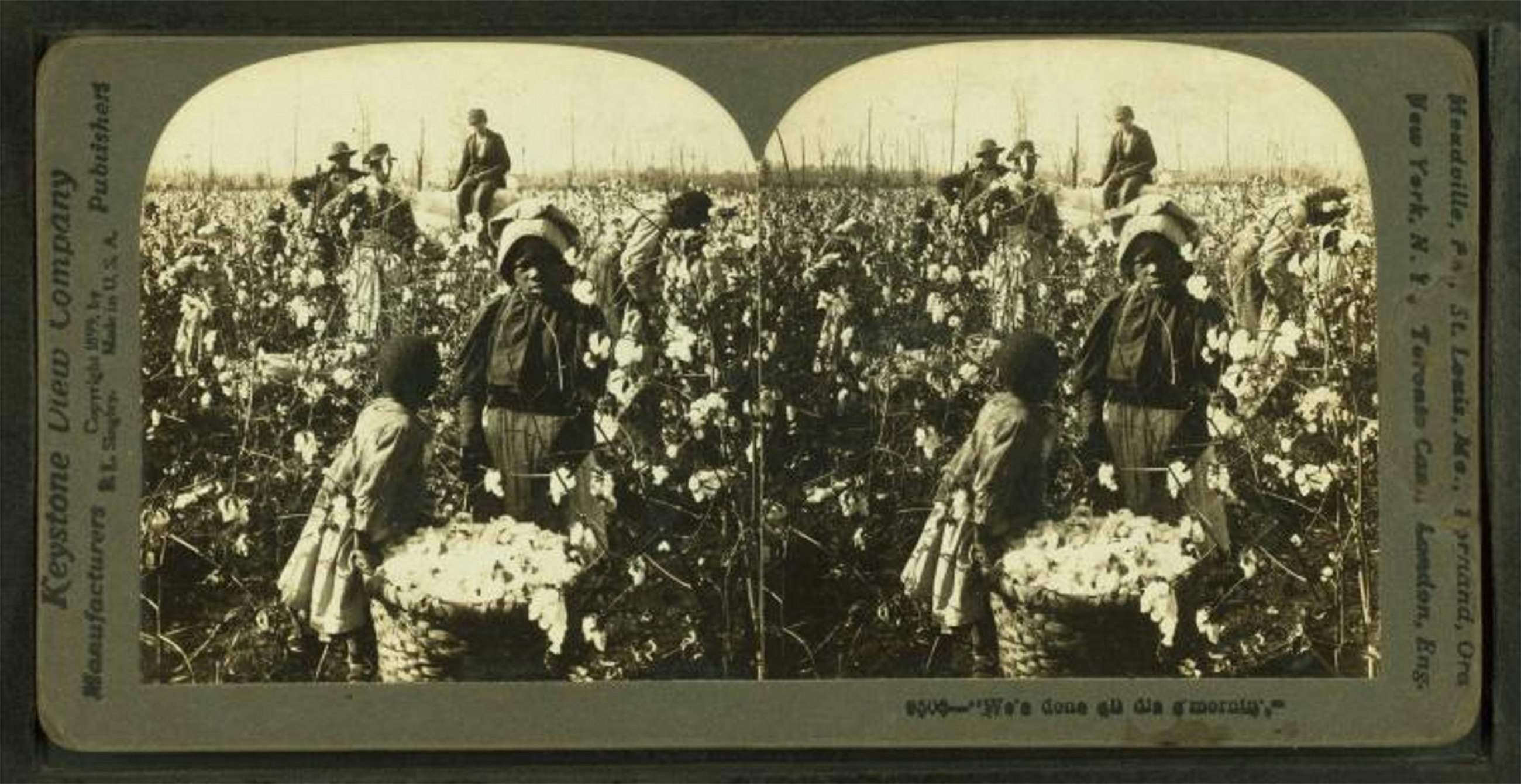
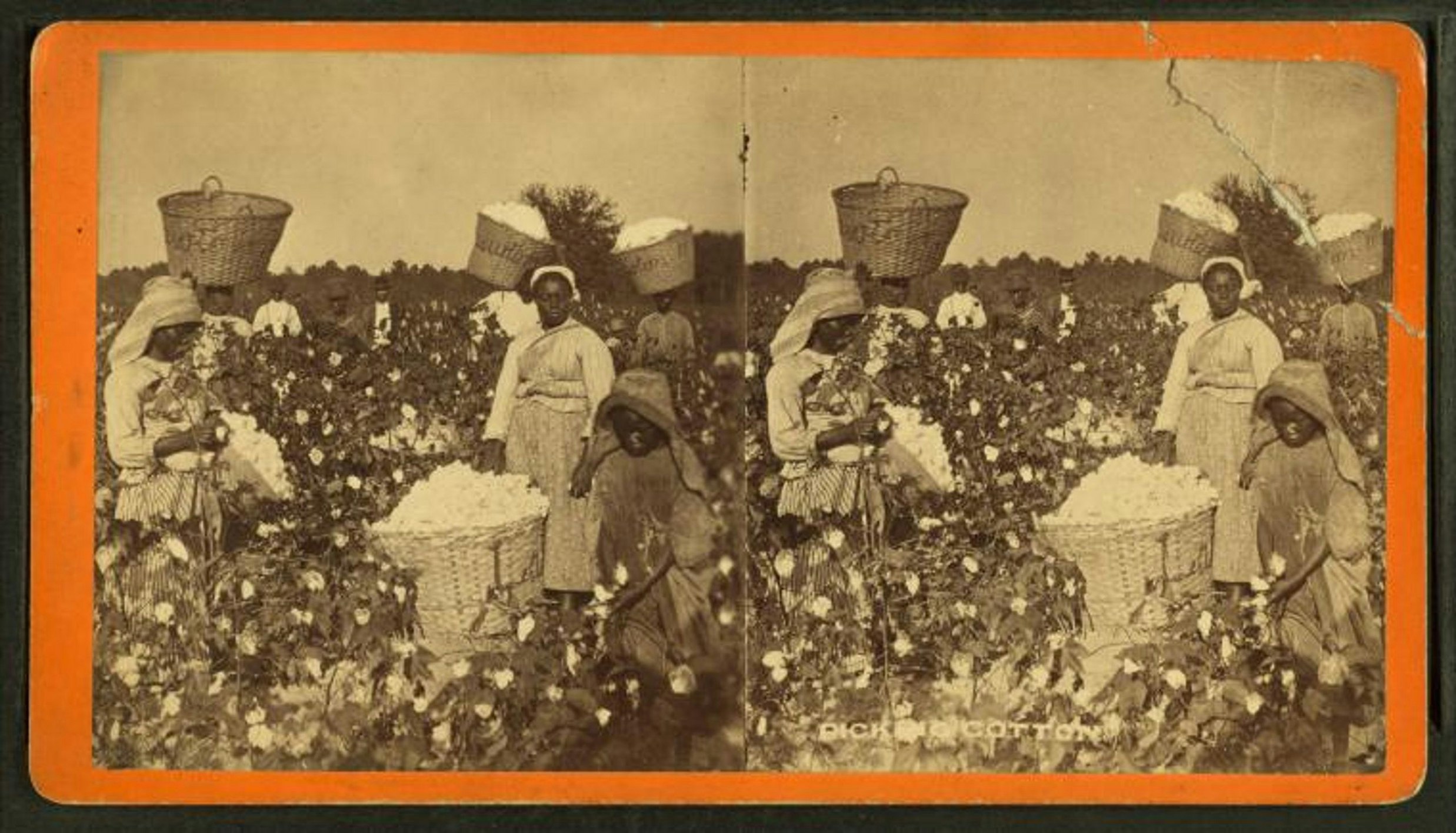
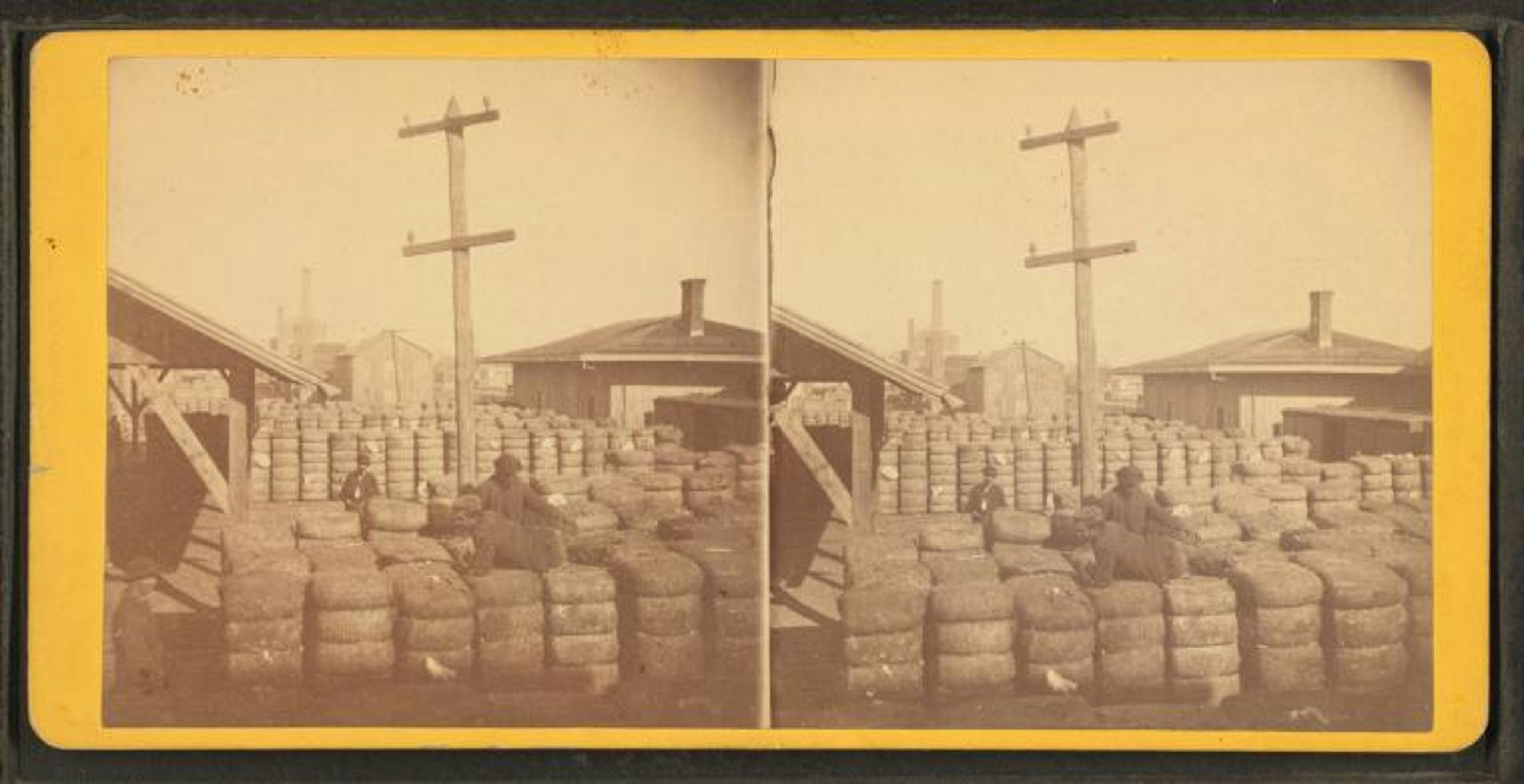



Transactions between Northern manufacturers like Lawrence and Southern slaveholders operated through the factorage system. Southern planters relied on factors—commercial agents—to negotiate the sale of commodities, chiefly cotton in the 19th century, produced by their enslaved laborers. Factors selected and stored the cotton bales, kept abreast of the price of cotton on the world market, and sold the commodity to various commercial houses. They then transported the raw material on freight trains and ships to the northern United States and across the Atlantic. The cotton they traded was the source of incredible wealth in the global economy.Go to footnote 309 detail As the historian Walter Johnson has written, the Southern plantation system converted “lashes into labor into bales into dollars into pound sterling,” and it made men like Lawrence into wealthy entrepreneurs and philanthropists.Go to footnote 310 detail
Lawrence had at least two agents in the South, one based in Richmond, Virginia, and one based in New Orleans, Louisiana.Go to footnote 311 detail He corresponded with both on the cost of cotton on the world market and political events in Europe that could affect commodity prices. William Gray, an agent for Lawrence’s Atlantic Cotton Mills, traveled between Boston, Lawrence, and New Orleans as he handled business transactions for the mill. In the course of his work, Gray corresponded with Greenleaf & Hubbard, a firm in New Orleans that traded in cotton from Southern plantations throughout the Mississippi Valley, and which had its own Harvard links.Go to footnote 312 detail
James Greenleaf
James Greenleaf, co-owner of Greenleaf & Hubbard, was the son of Harvard’s second Royall Professor of Law, Simon Greenleaf.Go to footnote 739 detail He was also a philanthropist and the builder of Greenleaf House, the historic Brattle Street mansion purchased by Radcliffe College in 1905. Greenleaf House served as the residence of Radcliffe College presidents and, more recently, deans of the Radcliffe Institute for Advanced Study.
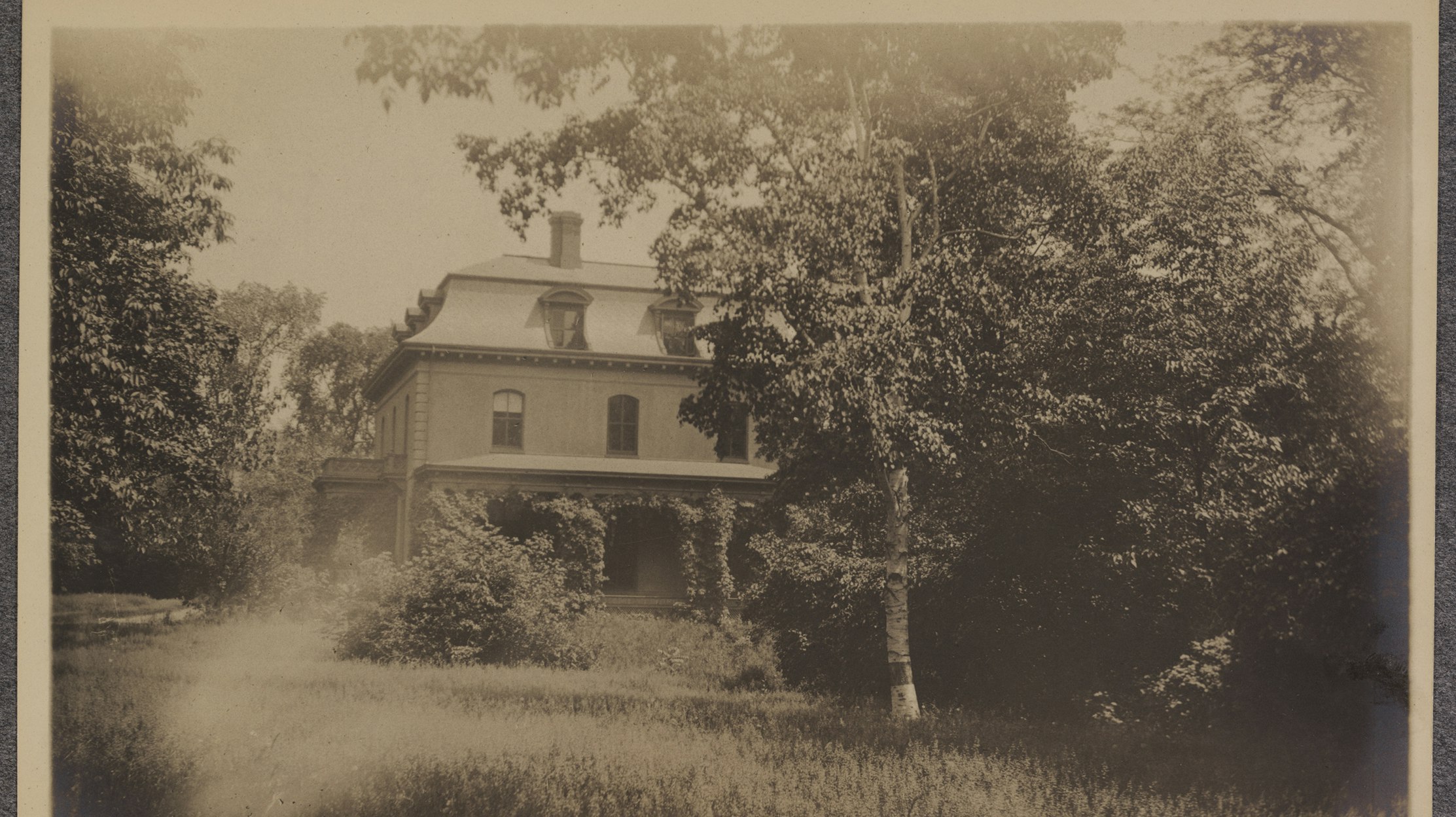
Greenleaf and his wife, Mary (Longfellow) Greenleaf, sister of Henry Wadsworth Longfellow (faculty, 1836–1854), divided their time between Cambridge and New Orleans, where Greenleaf and his business partner, Daniel Hubbard, operated from Canal Street.Go to footnote 313 detail The violence of slavery—and the auction block—would have been in full view throughout Greenleaf’s personal and professional life.Go to footnote 314 detail His primary business was the purchase of slave-grown cotton—generally by way of factors—and the sale of it to major Northern mills like Abbott Lawrence’s.Go to footnote 315 detail
Due to the structure of these transactions, it is difficult to determine precisely which plantations supplied Greenleaf & Hubbard,Go to footnote 316 detail but we do know that among them was Brierfield, owned by Jefferson Davis—the US senator from Mississippi and soon-to-be president of the Confederacy.Go to footnote 317 detail Also the site of Davis’s personal residence, Brierfield stood on Davis Bend, a peninsula in the Mississippi Delta with “rich alluvial soil” and direct access to the cotton market via the river.Go to footnote 318 detail Greenleaf & Hubbard worked with the firm Payne & Harrison, co-owned by Jacob U. Payne, who was not only a factor and a slave traderGo to footnote 320 detail but also “the most intimate friend Jefferson Davis ever had”Go to footnote 321 detail and, according his obituary in the Washington Post, “the largest cotton dealer in the world.”Go to footnote 322 detail
Footnotes
-
Edmund Randolph, “Narrative of the State of New England” (1676), quoted in Peterson, City-State of Boston, 154.
-
Governor William Lord Willoughby to the Privy Council, December 16, 1667, “America and West Indies: December 1667,” in Calendar of State Papers Colonial, America and West Indies: Volume 5, 1661-1668, ed. W. Noel Sainsbury (London, UK: Her Majesty's Stationery Office, 1880), 520-534, http://www.british-history.ac.uk/cal-state-papers/colonial/america-west-indies/vol5/pp520-534. See also Eric Williams, Capitalism and Slavery (Chapel Hill, NC: The University of North Carolina Press, 1994), 110, quoting also "America and West Indies: December 1667," in Calendar of State Papers Colonial, America and West Indies, vol. 5, 1661-1668, ed. W Noel Sainsbury (London, UK: Her Majesty's Stationery Office, 1880), 520-534.
-
See Kimball, “‘What have we to do with slavery?’,” 181.
-
Larry Gragg, “An Ambiguous Response to the Market: The Early New England-Barbados Trade,” Historical Journal of Massachusetts 17, no. 2 (Summer 1989): 177.
-
Edmund Burke, An account of the European settlements in America: In six parts. I. A short history of the discovery of that part of the world. II. The manners and customs of the original inhabitants. III. Of the Spanish settlements. IV. Of the Portuguese. V. Of the French, Dutch, and Danish. VI. Of the English. Each part contains an accurate description of the settlements in it, their extent, climate, productions, trade, genius and disposition of their inhabitants: the interests of the several powers of Europe with respect to those settlements; and their political and commercial views with regard to each other, 2 vols. (London, UK: Printed for R. and J. Dodsley in Pall-Mall, 1760), 2:173, https://books.google.com/books?id=6Wg6AAAAcAAJ.
-
Warren, New England Bound, 52.
-
Hosmer, Winthrop’s Journal, 2:328. See also Warren, New England Bound, 51.
-
Sir Charles Whitworth, State of the Trade of Great Britain in its Imports and Exports Progressively from the Year 1697 also of the Trade to each particular Country, during the above Period, distinguishing each year, in two parts with a Preface and Introduction Setting forth the Articles whereof each Trade consists, (London, UK: Printed for G. Robinson, etc., 1776), xlviii-xlviv.
-
Governor the Earl of Bellomont to the Council of Trade and Plantations, November 28, 1700, “America and West Indies: November 1700, 26–30,” in Calendar of State Papers Colonial, America and West Indies: Volume 18, 1700, ed. Cecil Headlam (London, UK: His Majesty’s Stationery Office, 1910), accessed March 2, 2022, https://www.british-history.ac.uk/cal-state-papers/colonial/america-west-indies/vol18/pp664-706, cited in Eric Bartholomew Kimball, “An Essential Link in a Vast Chain: New England and the West Indies, 1700–1775,” PhD diss. (University of Pittsburgh, 2009), 434, accessed March 7, 2024, https://d-scholarship.pitt.edu/7256/1/EricKimballDissertationMay12.pdf.
-
Kimball, “‘What have we to do with slavery?’,” 188, citing Andrés Poey, “A Chronological Table, Comprising 400 Cyclonic Hurricanes Which Have Occurred in the West Indies and in the North Atlantic within 362 Years from 1493 to 1855: With a Bibliographical List of 450 Authors, Books, &c., and Periodicals, Where Some Interesting Accounts May be Found, Especially on the West and East Indian Hurricanes,” The Journal of the Royal Geographical Society of London 25 (1855): 291–328.
-
John Josselyn, An Account of Two Voyages to New-England: made during the years 1638, 1663 (1674; reprint, Boston: William Veazie, 1865), 210-211. Peterson, City-State of Boston, 113, notes that Massachusetts fishermen sent “refuse fish”—mackerel, which was considered low-grade compared to cod—to the West Indies at low prices to be fed to enslaved people. Warren, New England Bound, 55, argues that “New England merchants were by midcentury racializing food: products understood to be beneath English standards were deemed sufficient for enslaved peoples in the West Indies. Rotting fish, however unappetizing to European stomachs, was a relative bargain for the feeding of slaves, for it cost so much less. Colonists could pocket the difference.”
-
“Testimony of George Walker of Barbados,” quoted in Christopher P. Magra, The Fisherman’s Cause: Atlantic Commerce and Maritime Dimensions of the American Revolution (New York, NY: Cambridge University Press, 2009), 95, cited in Kimball, “’What have we to do with slavery?’,” 186.
The West Indies also came to depend on New England’s whaling industry. In the 1750s, Nantucket whalers began to sell spermaceti head matter in Rhode Island, where chandlers turned this raw material into candles that were then exported to the Caribbean. By the eve of the American Revolution, over 90% of spermaceti candles in the Caribbean were imported from New England, with Rhode Island alone accounting for around 65% and Boston nearly 20% of the total. See Kimball, “’What have we to do with slavery?’,” 185, citing James B. Hedges, The Browns of Providence Plantations: Colonial Years (Cambridge, MA: Harvard University Press, 1952), 86–122; Alexander Starbuck, History of the American Whale Fishery from its Earliest Inception to the Year 1876 (Waltham, MA: printed by the author, 1878), 152–153.
Such artificial lighting was essential to Caribbean sugar plantations, enabling them to operate through the night during the harvest period. See, for example, Dunn, Sugar and Slaves, 195.
-
Philip D. Curtin, The Rise and Fall of the Plantation Complex: Essays in Atlantic History (New York, NY: Cambridge University Press, 1990), 83.
-
Richard Vines to John Winthrop, July 19, 1647, in Winthrop Papers, Volume V, 1645-1649 (Boston, MA: Massachusetts Historical Society, 1947), 172, https://archive.org/details/winthroppapersv5wint/page/n3/mode/2up, as cited in Bernard Bailyn, The New England Merchants in the Seventeenth Century (Cambridge, MA: Harvard University Press, 1955), 85.
-
For an index of sugar prices in Barbados between 1652 and 1694, see Otis Paul Starkey, The Economic Geography of Barbados: A Study of the Relationships Between Environmental Variations and Economic Development (New York, NY: Columbia University Press, 1939).
-
Curtin, Rise and Fall, 83.
-
Stanley L. Engerman and B. W. Higman, “The demographic structure of the Caribbean slave Societies in the eighteenth and nineteenth Centuries,” in General History of the Caribbean, ed. Franklin W. Knight, vol. 3, The slave societies of the Caribbean (New York, NY: Palgrave Macmillan, 2003), 48-50, table 2.1.
-
John Adams to Robert R. Livingston, 23 June 1783, Founders Online, National Archives, accessed February 4, 2022, https://founders.archives.gov/documents/Adams/06-15-02-0025, quoted in Kimball, “‘What Have We to Do with Slavery?’,” 190.
-
Halley, “My Isaac Royall Legacy.” It appears likely, as has been written elsewhere, that the Royalls were also involved in the brutal suppression of a planned rebellion of enslaved workers on Antigua. There is, however, some dispute about both whether there was a planned revolt at all, and whether the Royalls were directly involved in the violent crackdown. On the former question, David Barry Gaspar acknowledges that it is “much easier to gauge and authenticate a revolt than a conspiracy to revolt.” Yet he concludes there was indeed a plot to rebel. On the latter, the evidence is circumstantial but convincing: the fact that the Royalls would have been compelled to serve in the militia, paired with the fact that among those executed was a driver named Hector, enslaved by the Royalls, gives strong credence to their probable involvement. See David Barry Gaspar, Bondmen and Rebels: A Study of Master-Slave Relations in Antigua, (Durham, NC: Duke University Press, 1993), 5–13, 26, 32; and Janet Halley, “When Brands Go Bad: The Rise and fall, and Re-Rise and Re-Fall of Isaac Royall, Jr.,” in Academic Brands: Distinction in Global Higher Education, eds. Mario Biagioli and Madhavi Sunder (Cambridge University Press, Forthcoming).
-
See “Documenting Those Enslaved by the Royalls,” Royall House and Slave Quarters, accessed January 9, 2022, https://royallhouse.org/slavery/documenting-those-enslaved-by-the-royalls/.
-
See Samuel Francis Batchelder, Notes on Colonel Henry Vassall: His Wife Penelope Royall, His House at Cambridge, and His Slaves Tony & Darby (Cambridge, MA: 1917), 74-78, https://books.google.com/books?id=nJYlAQAAMAAJ, and J. L. Bell, Longfellow House-Washington’s Headquarters National Historic Site Historic Resource Study, (National Park Service, 2012), 31-41, https://www.nps.gov/long/learn/historyculture/upload/Washington-Headquarters-HRS.pdf.
-
This report focuses primarily on families other than the Royalls, about whom much has already been written. Coquillette and Kimball, “Isaac Royall, Jr.: Slave Master, Founder,” in Battlefield of Merit, 81-88; “HLS Shield Exhibit,” especially “The Legacy of Isaac Royall, Jr.,” Exhibit Addenda, Harvard Law School, accessed February 4, 2022, https://exhibits.law.harvard.edu/hls-shield-exhibit; and “Slavery,” Royall House and Slave Quarters, accessed February 4, 2022, https://royallhouse.org/slavery/ and “The Royalls,” Royall House and Slave Quarters, accessed February 4, 2022, https://royallhouse.org/the-royalls/.
-
Quoted in Peterson, City-State of Boston, 63; “George Downing to John Winthrop Jr.” (August 1645), Winthrop Papers, Volume V: 1645–1649 (Boston, MA: The Massachusetts Historical Society, 1947), 43, accessed August 30, 2021, https://archive.org/details/winthroppapersv5wint/mode/2up.
-
“George Downing to John Winthrop, Jr.,” 43,44.
-
Larry D. Gragg, “A Puritan in the West Indies: The Career of Samuel Winthrop,” The William and Mary Quarterly 50, no. 4 (October 1993): 768-786.
-
Gragg, “Puritan in the West Indies,” 774, 786; Warren, New England Bound, 59.
-
Vere Langford Oliver, The History of the Island of Antigua, One of the Leeward Caribbees, from the First Settlement in 1635 to the Present Time (London, UK: Mitchell and Hughes, 1894), 3:251, accessed August 26, 2021, https://archive.org/details/historyofislando03oliv/.
-
Bremer, John Winthrop, 174, and Reg Murphy, “Winthrope’s Bay,” ArchaeologyAntigua.org, accessed January 13, 2022, https://www.archaeologyantigua.org/index.php/winthrope-s-bay. The name, with a slight variation in spelling, is visible on contemporary maps. See “Winthorpes Bay,” Google Maps, accessed January 13, 2022, https://goo.gl/maps/KfUHSMUb9Wt52dPs8.
-
The original gift is recorded in an entry dated December 30, 1645: “Extractum Doni Pomarii Sociorum pour Johannem Bulkeleium,” box 2, College Books, 1636-1827, College Book 3, 1636-1779, UAI 5.5, Harvard University Archives, https://nrs.harvard.edu/urn-3:HUL.ARCH:10870587?n=47; transcribed in “Harvard College Records, Part I: Corporation Records, 1636-1750,” Colonial Society of Massachusetts, Publications of the Colonial Society of Massachusetts 15 (1895): 205-206.
As recently as 2008, Harvard University highlighted Winthrop’s gift as “the first gift of real estate by alumni” on a website describing the University’s endowment: “Harvard’s Endowment Funds,” The Harvard Guide: Finances, https://www.hno.harvard.edu/guide/finance/index.html (site archived by May 11, 2008), quoted in Manegold, 63. See also Morison, Three Centuries of Harvard, 17.
-
Samuel Winthrop to John Winthrop, 1647, Winthrop Family Papers, Massachusetts Historical Society. Translation published in Proceedings of the Massachusetts Historical Society, Second Series, vol. 7 (Boston, MA: Massachusetts Historical Society, 1892), 14-15.
-
Gragg, “Puritan in the West Indies,” 778.
-
Gragg, “Puritan in the West Indies,” 778; Samuel Winthrop to John Winthrop, Jr., November 1663 and September 1664, Winthrop Family Papers, Massachusetts Historical Society.
-
Samuel Winthrop to John Winthrop, Jr., September 1667, Winthrop Family Papers, Massachusetts Historical Society.
-
Gragg, “Puritan in West Indies,” 786.
While Samuel Winthrop’s will no longer exists, the property transactions and wills of his widow and children illustrate the wealth they inherited from him. See Oliver, Island of Antigua, 3:251–253.
-
See Samuel A. Eliot, A Sketch of the History of Harvard College and of its Present State (Boston, MA: Charles C. Little and James Brown, 1848).
-
See Beckert et al., Harvard and Slavery, 16.
-
James H. Perkins, Suffolk County, MA: Probate File Papers, AmericanAncestors.org, New England Historic Genealogical Society, 2017-2019, (from records supplied by the Massachusetts Supreme Judicial Court Archives, digitized images provided by FamilySearch.org), accessed March 5, 2021; Josiah Quincy, The History of Harvard University (Cambridge, MA: John Owen, 1840), 2:428-430, https://books.google.com/books?id=cC4BAAAAYAAJ; Harvard University, Quinquennial Catalogue, 1636-1915, 25.
-
“Our first men”: a calendar of wealth, fashion and gentility; containing a list of those persons taxed in the city of Boston, credibly reported to be worth one hundred thousand dollars, with biographical notices of the principal persons, rev. ed. (Boston, MA: Published by all the Booksellers, 1846), 36, https://books.google.com/books?id=1FzrR6lOnz8C. See also Michael E. Chapman, “Taking Business to the Tiger’s Gate: Thomas Handasyd Perkins and the Boston-Smyrna-Canton Opium Trade of the Early Republic,” Journal of the Royal Asiatic Society Hong Kong Branch 52 (2012), 7-28.
-
See Mary Jane McClintock Wilson, Master of Woodland Hill: Benjamin Bussey of Boston, 1757-1842 (Lansing, MI: self-pub., 2006).
-
Charles Warren, History of the Harvard Law School and Early Legal Conditions in America, vol. 2 (New York, NY: Lewis Publishing Company, 1908), 283.
-
Quincy, History of Harvard, 2:426-427. McLean’s will is transcribed in full in Thomas E. Bator and Heidi A. Seely, The Boston Trustee: The Lives, Laws & Legacy of a Vital Institution (Jaffrey, NH: David R. Godine, 2015), 139-145.
-
Sven Beckert, Balraj Gill, Jim Henle, and Katherine May Stevens, “Harvard and Slavery: A Short History,” in Slavery and University, ed. Harris et al., 232, citing Donations to Harvard College, 1844–1869, Box 2, Folder 19, seq. 5, Records of gifts and donations, 1643–1955, UAI 15.400, Harvard University Archives, https://nrs.lib.harvard.edu/urn-3:hul.arch:29739338?n=5.
-
Edward Lurie, Louis Agassiz: A Life in Science (Chicago, IL: University of Chicago Press, 1960), 137-138. Lawrence renewed his support for Agassiz’s salary in 1853. See Abbott Lawrence to Samuel Atkins Eliot, March 5, 1853, box 10, Corporation papers, 1853-1856, Corporation papers, 2nd series, supplements to the Harvard College Papers, UAI 5.130, Harvard University Archives. After Abbott Lawrence’s death, his son affirmed the family’s continuing support for Agassiz’s salary, until such time as the elder Lawrence’s $50,000 bequest could be paid to the University. See James W. Lawrence to William T. Andrews, Esq., November 12, 1855, box 10, Corporation papers, 1853-1856, Corporation papers, 2nd series, supplements to the Harvard College Papers, UAI 5.130, Harvard University Archives.
-
“School Overview: Timeline,” Harvard John A. Paulson School of Engineering and Applied Sciences, accessed January 7, 2022, https://www.seas.harvard.edu/about-us/school-overview/timeline.
-
Harvard University, Dedication of the Thomas Nelson Perkins Room in Massachusetts Hall to the Use of the President and Fellows of Harvard College (Cambridge, MA: Harvard University Press, 1941), v.
-
Harvard University Press, Perkins Room, vi.
-
Harvard University Press, Perkins Room, v-vi.
-
Harold Clarke Durrell, “Memoirs of Deceased Members of the New England Historic Genealogical Society: Thomas Nelson Perkins,” The New England Historical and Genealogical Register 92 (January 1938): 84-85.
-
Carl Seaburg and Stanley Paterson, Merchant Prince of Boston: Colonel T. H. Perkins, 1764-1854 (1971; repr., Cambridge, MA: Harvard University Press, 2014), 37-44; Benjamin Grande, “Yankees in Haiti: Boston Merchant Trade in Revolutionary Saint-Domingue” (master’s thesis, Tufts University, 2016), 72-105, http://hdl.handle.net/10427/011745.
-
Elizabeth Cary Agassiz was a granddaughter of Thomas Handasyd Perkins. She was also related to the Cushing family, who were business partners of the Perkins and were also a slave-trading family. Thomas Handasyd Perkins’s granddaughter, Mary Cary, married Harvard Professor Cornelius Conway Felton who became a President of Harvard University (1860-1862). Felton taught Greek at Harvard (Tutor, 1829-1832; university professor of Greek Literature, 1832-1834; and Eliot Professor of Greek Literature, 1849-1857). See Seaburg and Paterson, Merchant Prince of Boston, 433; Lucy Allen Paton, Elizabeth Cary Agassiz: A Biography (Boston, MA: Houghton Mifflin Company, 1919), 4, https://books.google.com/books?id=25AAAAAAYAAJ; William Richard Cutter, ed., Genealogical and Personal Memoirs Relating to the Families of the State of Massachusetts, vol. 4 (New York, NY: Lewis Historical Publishing Company, 1910), 2193, https://books.google.com/books?id=FM8UAAAAYAAJ. Harvard University, Quinquennial Catalogue, 1636-1915, 56.
-
Harvard University, Quinquennial Catalogue, 1636–1915, 25; “[Meetings of 1823]—Memoir of James Perkins,” in Proceedings of the Massachusetts Historical Society, vol. 1 (Boston, MA: Massachusetts Historical Society, 1791), 348–71; Samuel A. Eliot, Harvard College and Its Benefactors (Boston, MA: C.C. Little and J. Brown, 1846), https://books.google.com/books?id=-Xg7AAAAYAAJ.
-
Quincy, History of Harvard, 2:546-548, 564.
-
N. I. Bowditch, A History of the Massachusetts General Hospital (Boston, MA: John Wilson & Son, 1851), 416, 432, https://books.google.com/books?id=qg8DAAAAQAAJ.
On its website, Massachusetts General Hospital is described as “the first teaching hospital of Harvard University’s new medical school” when it was established. “About Us: The Mass General Difference,” Massachusetts General Hospital, accessed November 9, 2021, https://www.massgeneral.org/about/. On the work of Dr. John Collins Warren, first Dean of Harvard Medical School, to found MGH, see Edward Warren, The Life of John Collins Warren, M. D., Compiled Chiefly from His Autobiography and Journals (Boston, MA: Ticknor and Fields, 1860), 1:98–102, https://books.google.com/books?id=Wcc0AQAAMAAJ, and Bowditch, Massachusetts General Hospital, 3. Bowditch also lists Harvard among the original subscribers to the fundraising effort for the hospital, see Massachusetts General Hospital, 402.
-
Quincy, History of Harvard, 2:291, 543. The professorship was renamed after an 1833 bequest by Dr. Joshua Fisher. See Quincy, History of Harvard, 2:428, 628 and “Asa Gray at 200: Harvard Professor,” Harvard University Herbaria and Libraries, accessed January 21, 2022, https://huh.harvard.edu/book/harvard-professor.
Between them, the three brothers also supported the Astronomical Observatory, the libraries, a fundraising effort to build an exhibition space, and students; see Quincy, History of Harvard, 2:401, 488, 592-593, 637, and Eliot, History of Harvard College, 182.
-
“[Meetings of 1823] – Memoir of James Perkins.”
-
Thomas G. Cary, Memoir of Thomas Handasyd Perkins; containing Extracts from his Diaries and Letter. With an Appendix (Boston, MA: Little, Brown, 1856), 223, https://books.google.com/books?id=QKwpAAAAYAAJ; Anna Gardner Fish, “Thomas Handasyd Perkins,” Founders, Perkins History Museum, Perkins School for the Blind, accessed August 13, 2021, https://www.perkins.org/founders/#TH-Perkins.
-
Seaburg and Paterson, Merchant Prince of Boston, 33-34.
-
Cary, Perkins, 5-6; Seaburg and Paterson, Merchant Prince of Boston, 33.
-
Robin Blackburn, The Overthrow of Colonial Slavery, 1776-1848 (New York, NY: Verso, 1988); Laurent Dubois, Avengers of the New World: The Story of the Haitian Revolution (Cambridge, MA: The Belknap Press of Harvard University Press, 2004); Carolyn E. Fick, The Making of Haiti: The Saint Domingue Revolution from Below (Knoxville, TN: University of Tennessee Press, 1990).
-
Seaburg and Paterson, Merchant Prince of Boston, 62.
-
Stanley L. Engerman and B. W. Higman, “The demographic structure of the Caribbean slave societies in the eighteenth and nineteenth centuries,” General History of the Caribbean, ed. Franklin W. Knight, vol. 3, The slave societies of the Caribbean (New York, NY: Palgrave Macmillan, 2007), 60.
-
Sarah Perkins to Eliza Trumbull, Cape François, November 13, 1789, MSS. L 816, box 3, subseries 3, item 3, Perkins Family Papers, 1780-1882, Boston Athenaeum, Massachusetts.
-
Seaburg and Paterson, Merchant Prince of Boston, 34; Charles C. Perkins, “Narrative of the Insurrection in St. Domingo, and of a Voyage from Port au Prince to Boston in 1793, by Samuel G. Perkins, communicated, with notes,” Proceedings of the Massachusetts Historical Society, vol. 2, Second Series 1885-1886 (Boston, MA: Massachusetts Historical Society, 1886), 305-306.
-
Perkins, “Insurrection in St. Domingo,” 307.
-
“The Copartnership, under the firm of Wall, Tardy and Co. of Cape-François,” Advertisement, The Massachusetts Centinel, June 7, 1786; Seaburg and Paterson, Merchant Prince of Boston, 39-40.
-
Seaburg and Paterson, Merchant Prince of Boston, 40. In July 1792, Samuel Gardner wrote from St. Domingue to James of going in with a partner to purchase some newly imported enslaved Africans: “a ship arrived from the coast with slaves & we immediately proposed purchasing together, but as I was extremely busy he went on board [and] visited the negroes.” He describes boarding the slave ships as part of the normal course of business, and makes it clear that had not been otherwise occupied he would have gone himself. Samuel G. Perkins to James Perkins, July 16, 17, 1792, box 1, item 10, Perkins Family Papers, 1780-1882, MSS. L816, Boston Athenaeum, Massachusetts.
-
See, for example, Captain Josiah Wardwell to Walter Burling, Havana, May 21, 1792, box 2, item 4, Perkins Family Papers, 1780-1882, MSS. L816, Boston Athenaeum, Massachusetts; Samuel G. Perkins to James Perkins, Cape, May 27, 1792, box 2, item 6, Perkins Family Papers, 1780-1882, MSS. L816, Boston Athenaeum, Massachusetts; Captain Josiah Wardwell to Perkins, Burling, & Co., Havana, May 25, 1792, box 2, item 7, Perkins Family Papers, 1780-1882, MSS. L816, Boston Athenaeum, Massachusetts; Captain Josiah Wardwell to Perkins, Burling, & Co., New York, July 5, 1792, box 2, item 30, Perkins Family Papers, 1780-1882, MSS. L816, Boston Athenaeum, Massachusetts; J. Walke to James Perkins, New York, July 6, 1792, box 2, item 31, Perkins Family Papers, 1780-1882, MSS. L816, Boston Athenaeum, Massachusetts; Walter Burling to James Perkins, Cape, July 27, 1792, box 2, item 38, Perkins Family Papers, 1780-1882, MSS. L816, Boston Athenaeum, Massachusetts.
-
Captain Burk to James Yard, “At Sea,” June 16, 1792, box 2, item 15, Perkins Family Papers, 1780-1882, Boston Athenaeum, Massachusetts.
-
H. LeMesurier & Co. to James Perkins, Havre, August 31, 1792, box 1, item 3, Perkins Family Papers, 1780-1882, Boston Athenaeum, Massachusetts; John Fuller to Thomas H. Perkins, Philadelphia, September 15, 1790, film A. 842, reel 1, box 1, Thomas Handasyd Perkins Papers, 1789-1892, Massachusetts Historical Society, microfilm.
-
Dubois, Avengers of the New World; Fick, The Making of Haiti; Michel-Rolph Trouillot, Silencing the Past: Power and the Production of History (Boston, MA: Beacon Press, 1995).
-
N. Goldthwait to James Perkins, Turks Island, December 18, 1792, box 1, item 4, Perkins Family Papers, 1780-1882, MSS. L816, Boston Athenaeum, Massachusetts.
-
Seaburg and Paterson, Merchant Prince of Boston, 89; Ada Ferrer, Freedom’s Mirror: Cuba and Haiti in the Age of Revolution (New York, NY: Cambridge University Press, 2014).
-
This man’s name is spelled variously both within and across multiple sources. We have chosen to use the name and spelling used in his obituary, printed by the abolitionist newspaper The Liberator in 1831. See “DIED [Mousse],” The Liberator (Boston, MA), November 5, 1831.
-
“[Meetings of 1823] – Memoir of James Perkins,” 358.
-
“DIED [Mousse],” The Liberator.
-
Samuel G. Perkins to James Perkins, Cape, May 27, 1792.
-
Samuel Perkins to James Perkins, June 28, 1792, box 2, item 20, Perkins Family Papers, 1780-1882, MSS. L816, Boston Athenaeum, Massachusetts; PB&Co to James Perkins, Cape, August 5, 1792, box 1, item 14, Perkins Family Papers, 1780-1882, MSS. L816, Boston Athenaeum, Massachusetts.
-
Samuel G. Perkins to James Perkins, October 26, 1792, Cape, box 1, item 14, Perkins Family Papers, 1780-1882, MSS. L816, Boston Athenaeum, Massachusetts.
-
Perkins, “Insurrection in St. Domingo,” 306, 374-390.
-
Edith Perkins Cunningham, Owls Nest: A Tribute to Sarah Elliott Perkins (Cambridge, MA: Riverside Press, 1907), 19, https://books.google.com/books?id=jHAaAAAAYAAJ.
-
Perkins, “Insurrection in St. Domingo,” 348, 353.
-
Ralph W. Hidy, “Editor’s Foreward,” in Seaburg and Paterson, Merchant Prince of Boston, vii-viii; Our First Men, 35-36; Chapman, “Taking Business to Tiger’s Gate.”
-
See Martha Bebinger, “How Profits from Opium Shaped 19th-Century Boston,” WBUR, July 31, 2017, https://www.wbur.org/news/2017/07/31/opium-boston-history.
-
Quincy, History of Harvard, 2:428. In preparing this biographical sketch Quincy consulted Thomas Handasyd Perkins, who composed for Quincy a narrative of his brother’s life. Like Quincy’s published version, Thomas’s sketch praises James’s mercantile success in St. Domingo without detailing the nature of the brothers’ business. Thomas Handasyd Perkins to Josiah Quincy, December 13, 1838, Boston, box 3, item 23, Perkins Family Papers, 1780-1882, MSS. L816, Boston Athenaeum, Massachusetts.
-
Quincy, History of Harvard, 2:428-429.
-
Eliot, Harvard College and Its Benefactors, 180; Quincy, History of Harvard, 2:412-413.
-
Quincy, History of Harvard, 2:413.
-
Josiah Quincy, Considerations relative to the Library of Harvard university, respectfully submitted to the Legislature of Massachusetts (Cambridge, MA: Charles Folsom, 1833), 5.
-
Bowditch, Massachusetts General Hospital, 430. On the hospital’s relationship to the University, see footnote 207 above.
-
Quincy, History of Harvard, 2:546-548, 583.
-
Quincy, History of Harvard, 2:412, 544-545.
-
Bertram Zarins, “History of the Massachusetts General Hospital Sports Medicine Service,” The Orthopaedic Journal at Harvard Medical School 9 (2007): 100, http://www.orthojournalhms.org/volume9/manuscripts/ms13.pdf.
-
See “Collection Overview: Scope and Contents,” Israel Thorndike Business Records, Hollis for Archival Discovery, Harvard Library, accessed January 7, 2022, https://id.lib.harvard.edu/ead/bak00405/catalog. Also Volume 1, 1781-1788, box 1, folder 2, Israel Thorndike business records, Mss:766 1778-1899, Baker Library Special Collections, Harvard Business School; Volume 1, 1789-1790, box 1, folder 3, Israel Thorndike business records, Mss:766 1778-1899, Baker Library Special Collections, Harvard Business School; Volume 1, 1792, box 15, folder 2, Israel Thorndike business records, Mss:766 1778-1899, Baker Library Special Collections, Harvard Business School; Volume 1, 1795-1796, box 1, folder 11, Israel Thorndike business records, Mss:766 1778-1899, Baker Library Special Collections, Harvard Business School.
-
Thorndike’s brother-in-law and business partner, Moses Brown (AB AM 1768), was also a benefactor of the Divinity School, bequeathing $2,000 to the institution upon his death in 1820. Quincy, History of Harvard, , 2:414-415.
-
“Orders to Nicholas Thorndike from Brown & Thorndike,” October 11, 1791, 18460 – Correspondence, Historic Beverly, Massachusetts, https://beverlyhistory.pastperfectonline.com/archive/63CB7150-96A9-40C7-A1E3-312313391417.
-
Timothy Kistner, Federalist Tycoon: The Life and Times of Israel Thorndike (Lanham, MD: University Press of America, Inc., 2015), 30-31, 49-50.
-
See, for example, “Bill between Nicholas Thorndike and Brown & Thorndike,” February 10, 1792, 18483 – Bill of Sale, Historic Beverly, Massachusetts, https://beverlyhistory.pastperfectonline.com/archive/E697F9A5-C2A9-4E68-BAB9-270264606260; “Bill of sales by Brown & Thorndike in account of Nicholas Thorndike,” February 28, 1792, 18484 – Bill of Sale, Historic Beverly, Massachusetts, https://beverlyhistory.pastperfectonline.com/archive/86F5C109-BF6A-4F44-98B1-134304130828; “Update of orders from Nicholas Thorndike in Havanna probably to Brown & Thorndike,” May 1, 1793, 18525 – Document, Historic Beverly, Massachusetts, https://beverlyhistory.pastperfectonline.com/archive/E9A7A606-DA29-4D59-86C3-974130912571; W. Woodville to Israel Thorndike and John Lovett, December 16, 1801, 12847 – Document, Historic Beverly, Massachusetts, https://beverlyhistory.pastperfectonline.com/archive/9ABCA58C-18AB-47F4-900D-950629950107.
-
See Kistner, Federalist Tycoon, 41-110, 137-170.
-
Quincy, History of Harvard, 2:426.
-
On the total amount received by the hospital, encompassing both McLean’s original bequest and residuary income, see Quincy, History of Harvard, 2:426, and Bowditch, Massachusetts General Hospital, 429. On the hospital’s historical relationship to Harvard Medical School, see note 207, above.
For a more in-depth discussion of John McLean’s legacies, see Bator and Seely, Boston Trustee.
-
Bowditch, Massachusetts General Hospital, 419, 429-430.
-
Bowditch, Massachusetts General Hospital, 75-76.
-
“History & Progress: Over 200 Years of Treatment, Research, Training and Education,” McLean Hospital, accessed, September 24, 2021, https://www.mcleanhospital.org/about/history-progress.
-
Quincy, History of Harvard, 2:426.
-
Cyrus Eaton, Annals of the Town of Warren, with the Early History of St. George’s, Broad Bay and the Neighboring Settlements on the Waldo Patent (Hallowell, ME: Masters, Smith & Co., 1851), 119, https://books.google.com/books?id=qYHc3-EYCygC.
-
Ship Registers and Enrollments of Boston and Charlestown, vol. 1, 1789–1795, compiled by The Survey of Federal Archives Division of Professional and Service Projects, Works Progress Administration (Boston, MA: The National Archives Project, 1942), 11, 34, 43, 47, 61, 103, 138, 152, 185, 203, https://books.google.com/books?id=v-NFAQAAIAAJ.
-
French Spoliations: A Condensed Report of the Findings of the Court of Claims in Each Case Named in the Amendment Proposed by Senator Lodge to H. R. 19115 (Washington, DC: Government Printing Office, 1912), 9-10, 56-60, 92-93, 101-102, 116-118, 123-124, 146-147, 182-183, https://books.google.com/books?id=ikZHAQAAMAAJ.
-
Warren, Harvard Law School, 2:21. Warren’s transcription varies slightly but not substantively from the original, primarily in punctuation. See Benjamin Bussey Probate Record, 1842, Norfolk County, Massachusetts, Probate File Papers, 1793-1877, AmericanAncestors.org, New England Historic Genealogical Society, 2019, p. 3, (from records supplied by the Massachusetts Supreme Judicial Court Archives, digitized images provided by FamilySearch.org), accessed March 5, 2021.
-
“Will of Benjamin Bussey,” in Bussey Probate Record, 12-13.
-
Warren, Harvard Law School, 2:283-284. Bussey also was a Lifetime Subscriber to the fundraising effort for the creation of “the Theological School in Harvard University”—now Harvard Divinity School—and in 1805 he donated $300 to the creation of the Massachusetts Professorship of Natural History, now the Fisher Professor of Natural History. In addition to his support of Harvard University, Bussey was also an early donor to the Massachusetts General Hospital. He is listed among the original subscribers to that institution, with a pledge of $1,000, in Bowditch, Massachusetts General Hospital, 412. The receipt issued to Bussey for this donation is held in the University of Michigan archives: James Prince, Treasurer, Receipt for donation to Massachusetts General Hospital, January 3, 1818, box 1, folder 19, Benjamin Bussey Collection, 1767-1872, University of Michigan Library.
-
“Memorial Hall Sculptures,” Office for the Arts at Harvard: Memorial Hall / Lowell Hall Complex, accessed October 25, 2021, https://sites.fas.harvard.edu/~memhall/sculptures.html; Shobal Vail Clevenger, Benjamin Bussey (1757–1842), 1839, marble, 73 x 51 x 33 cm, Harvard Art Museums, https://hvrd.art/o/305329.
-
Gilbert Stuart, Benjamin Bussey (1757-1842), 1809, oil on panel, frame by John Doggett, 101.9 x 86.4 x 9.5 cm (framed), Harvard Art Museums, https://hvrd.art/o/299878.
-
Benjamin Bussey’s Life ([Boston, MA?]: B. Bussey, 1841), 4.
-
See Brown University, Slavery and Justice, 10, 22.
-
Benjamin Bussey’s Life, 4. A transcription of the document was published in The Dedham Historical Register, vol. 10, no. 3 (Dedham, MA: Dedham Historical Society, 1899), 71–76, https://books.google.com/books?id=fw8MAAAAYAAJ.
For secondary accounts of Bussey’s life, in addition to Warren, Harvard Law School, see Mary Jane Wilson, “Benjamin Bussey, Woodland Hill, and the Creation of the Arnold Arboretum,” Arnoldia 64, no. 1 (2005): 2–9, http://arnoldia.arboretum.harvard.edu/pdf/articles/2006-64-1-benjamin-bussey-woodland-hill-and-the-creation-of-the-arnold-arboretum.pdf; Wilson, Woodland Hill; and Coquillette and Kimball, Battlefield of Merit, 183, n. 32.
-
French Spoliations, 7-8, 21-22, 56-60, 75, 89-90, 123-124, and 143-144. A typical voyage carried oxen, barrel hoops and staves, cheese, Indian corn, butter, lard, beef, fish, pork, and potatoes from New Haven, Connecticut, to Martinique in 1798.
Bussey’s business correspondence further documents his trade with the West Indies. See, for example, Oliver Putnam to Benjamin Bussey, March 22, 1806, box 1, folder 4, Benjamin Bussey Collection, 1767-1872, University of Michigan Library; William Savage to Oliver Putnam, August 11, 1806, box 1, folder 5, Benjamin Bussey Collection, 1767-1872, University of Michigan Library; and William Savage to Oliver Putnam, October 20, 1806, box 1, folder 5, Benjamin Bussey Collection, 1767-1872, University of Michigan Library.
The finding aid for the Benjamin Bussey Collection at the University of Michigan is available online at https://quod.lib.umich.edu/c/clementsead/umich-wcl-M-1016bus. Noteworthy correspondents include military and political figures, major Boston merchants such as fellow Harvard donors James and Thomas Handasyd Perkins and Israel Thorndike, and an assortment of other prominent people. Material in the collection also illustrates the geographic extent of Bussey’s business interests, covering business dealings in Europe, the West Indies, and Mexico, as well as within the United States from Maine in the north to New Orleans, Louisiana, in the south.
-
“Dr. Benjamin Bussey in Acct of an Adventor [sic] in the Brig Providence with Jon.a Arnold to New Orleans in the year 1789,” June 20, 1796, box 1, folder 1, Benjamin Bussey Collection, 1767–1872, University of Michigan Library.
On tow cloth see for example Gloria Seaman Allen, “‘For the People’: Clothing Production and Maintenance at Rose Hill Plantation, Cecil County, Maryland,” Historic Alexandria Quarterly (winter 2003): 4, https://www.alexandriava.gov/uploadedfiles/historic/haq/HistoricAlexandriaQuarterly2003Winter.pdf. Advertisements searching for enslaved people who had run away from their enslavers frequently describe them in tow cloth garments. See Jonathan Prude, “To Look upon the ‘Lower Sort’: Runaway Ads and the Appearance of Unfree Laborers in America, 1750–1800,” The Journal of American History 78, no. 1 (June 1991): 145; Lauren Landi, “Reading Between the Lines of Slavery: Examining New England Runaway Ads for Evidence of an Afro-Yankee Culture,” Pell Scholars and Senior Theses, 78 (2012): 39–48, https://digitalcommons.salve.edu/pell_theses/78.
-
Contacts in North Carolina, South Carolina, and multiple locations in Georgia are recorded in: Charles Davis to Samuel Howard, May 18, 1802, box 1, folder 3, Benjamin Bussey Collection, 1767-1872, University of Michigan Library; Richard Langdon to Benjamin Bussey, June 26, 1807, box 1, folder 6, Benjamin Bussey Collection, 1767-1872, University of Michigan Library; E. Crane, Jr. to Benjamin Bussey, October 23, 1815, box 1, folder 16, Benjamin Bussey Collection, 1767-1872, University of Michigan Library; and Roswell King to Benjamin Bussey, August 20, 1816, box 1, folder 17, Benjamin Bussey Collection, 1767-1872, University of Michigan Library.
-
Receipt for Charles Davis’ passage on the Brig Eleanor, January 2, 1802, box 1, folder 3, Benjamin Bussey Collection, 1767-1872, University of Michigan Library.
-
Charles Davis to Mr. Samuel Howard, May 18, 1802, box 1, folder 3, Benjamin Bussey Collection, 1767-1872, University of Michigan Library.
-
Charles Davis to Mr. Samuel Howard, May 25, 1802, box 1, folder 3, Benjamin Bussey Collection, 1767-1872, University of Michigan Library.
Other correspondence kept Bussey informed of the prices he could expect to receive for various plantation goods in Europe. See, for example, Thos. and A.O. Cremer to Benjamin Bussey, April 28, 1807, box 1, folder 6, Benjamin Bussey Collection, 1767-1872, University of Michigan Library; Wm. Hoskins to Benjamin Bussey, September 18, 1812, box 1, folder 12, Benjamin Bussey Collection, 1767-1872, University of Michigan Library.
-
Jaazaniah Bussey to Benjamin Bussey, January 2, 1793, box 1, folder 1, Benjamin Bussey Collection, 1767-1872, University of Michigan Library; Arch Ewing to Benjamin Bussey, January 25, 1795, box 1, folder 1, Benjamin Bussey Collection, 1767-1872, University of Michigan Library; and Robert Gray to Benjamin Bussey, August 22, 1800, box 1, folder 2, Benjamin Bussey Collection, 1767-1872, University of Michigan Library.
-
See French Spoliations, 56-60, 123-124, 143-144.
-
“Schedule A referred to in the annexed account: Sums rec’d by the Executors [1842-1843],” Will of Benjamin Bussey, Bussey Probate Record.
-
“Fay House,” Harvard Property Information Resource Center, Harvard University, accessed January 6, 2022, https://harvardplanning.emuseum.com/sites/544/fay-house?ctx=1cb551379ee5a8cd29a91ae8111f07d7e19f685f&idx=0.
-
Josiah Quincy to Benjamin Bussey, July 2, 1824, box 1, folder 22, Benjamin Bussey Collection, 1767-1872, University of Michigan Library. The purchase is confirmed by Suffolk County property records: “Benjamin Bussey to the City of Boston,” Massachusetts Land Records, 1620-1986, Suffolk Deeds 1824, vol. 291-292, county courthouses and offices, Massachusetts, image 250 of 681, familysearch.com, accessed September 23, 2021.
-
Compare Carleton Osgood, “A plan of Boston: from actual survey” [Boston, MA?: s.n., 1805?], https://lccn.loc.gov/2011589290, and View of Quincy Market, Boston, Google Maps, accessed October 25, 2021, https://goo.gl/maps/jbFpcZDWf74fgstx8.
-
“Will of Benjamin Bussey,” in Bussey Probate Record, 5. Bussey’s summer estate in Roxbury is now the site of the Arnold Arboretum. His papers include various correspondence about his interests in Maine—an interest he shared with fellow Harvard donor and Maine landholder Israel Thorndike. The way in which these Harvard donors’ land dealings in Maine impacted local Native communities, including the Penobscot and Passamaquoddy, is an important area for future research.
-
Josiah Quincy to Judith Bussey, August 28, 1842, box 1, folder 32, Benjamin Bussey Collection, 1767-1872, University of Michigan Library.
-
E.D. Merrill, “The Atkins Institution of the Arnold Arboretum, Soledad, Cienfuegos, Cuba,” Bulletin of Popular Information, 4th ser., 8, no. 13 (December 13, 1940): 66, http://arnoldia.arboretum.harvard.edu/pdf/articles/1940-8--the-atkins-institution-of-the-arnold-arboretum-soledad-cienfuegos-cuba.pdf.
-
Ferrer, Freedom’s Mirror.
-
Rebecca J. Scott, “A Cuban Connection: Edwin F. Atkins, Charles Francis Adams, Jr., and the Former Slaves of Soledad Plantation,” The Massachusetts Historical Review 9 (2007): 7–34; Rebekah E. Pite, “The Force of Food: Life on the Atkins Family Sugar Plantation in Cienfuegos, Cuba, 1884–1900,” The Massachusetts Historical Review 5 (2003): 58–93. Slavery was abolished in Cuba in 1886. Rebecca J. Scott, “Gradual Abolition and the Dynamics of Slave Emancipation in Cuba, 1868–86,” The Hispanic American Historical Review 63, no. 3 (August 1983): 449–477.
-
Louis A. Pérez, Cuba and the United States: Ties of Singular Intimacy, 3rd ed. (Athens, GA: University of Georgia Press, 2003), 56-61. See Denise S. Davis-Oyesanya, “E. Atkins and Company and the sugar trade in Cuba” (PhD diss., University of Oklahoma, 1996), 31-64; Marion D. Cahan, “The Harvard Garden in Cuba—A Brief History,” Arnoldia 51, no. 3 (Fall 1991): 26-27, http://arnoldia.arboretum.harvard.edu/pdf/articles/1991-51-3-the-harvard-garden-in-cuba-a-brief-history.pdf.
-
Scott, “Cuban Connection,” 8-9.
-
Scott, “Cuban Connection,” 10.
-
Edwin F. Atkins to J. S. Murray, April 25, 1884, vol. 2.5, July 27, 1883-November 29, 1884, Letterbooks, 1878-1912, Correspondence, 1875-1919, Edwin F. Atkins Papers, 1875-1950, Atkins Family Papers, Ms. N-297, Massachusetts Historical Society.
-
See Edwin F. Atkins to J. S. Murray, May 25, 1884, vol. 4.1, April 23, 1884-January 7, 1885, Letterbooks, 1878-1912, Correspondence, 1875-1919, Edwin F. Atkins Papers, 1875-1950, Atkins Family Papers, Ms. N-297, Massachusetts Historical Society. See also Pite, “Force of Food,” 61-63.
On July 15, 1884, Murray informed Atkins that the Cuban Civil Guard had shot and killed a “runaway negro” employed by a Soledad estate contractor who, under the law, did not have the right to leave the plantation on which he was indentured. Murray described the event as “very disagreeable,” but hastened to assure Atkins that “it was no fault of anyone on the estate.” Atkins wrote to Murray twice in the following weeks responding to several issues Murray raised in his letter of July 15, 1884. He did not respond to the news of lethal violence against the worker on his property. J. S. Murray to Edwin F. Atkins, July 15, 1884, box 4.1, April 15, 1884-November 15, 1885, J. S. Murray, 1884-1893, Letterbooks, 1884-1916, Soledad Sugar Co. Records, 1884-1916, Atkins Family Papers, Ms. N-297, Massachusetts Historical Society; Edwin F. Atkins to J. S. Murray, July 23 and July 30, 1884, vol. 4.1, April 23, 1884-January 7, 1885, Edwin F. Atkins, 1884-1916, Letterbooks, 1884-1916, Soledad Sugar Co. Records, 1884-1916, Atkins Family Papers, Ms. N-297, Massachusetts Historical Society.
-
J. S. Murray to Edwin F. Atkins, June 19, 1884, box 4.1, April 15, 1884–November 15, 1885, J. S. Murray, 1884–1893, Letterbooks, 1884–1916, Soledad Sugar Co. Records, 1884–1916, Atkins Family Papers, Ms. N-297, Massachusetts Historical Society; see also Kathleen López and Rebekah E. Pite, “Appendix,” in “Letters from Soledad in the Atkins Family Papers at the Massachusetts Historical Society,” Massachusetts Historical Review 9 (2007): 39.
-
Scott, “Cuban Connection,” 10, 26.
-
Beckert, Gill, Henle, and Stevens, “Harvard and Slavery,” in Slavery and University, ed. Harris et al., 242. See also Beckert et al., Harvard and Slavery, 23.
-
Merrill, “Atkins Institution,” 70.
-
Merrill, “Atkins Institution,” 66.
-
Liz Mineo, “Between Cuba and Harvard, an uncommon Garden,” Harvard Gazette, August 1, 2016, https://news.harvard.edu/gazette/story/2016/08/between-cuba-and-harvard-an-uncommon-garden/; Cahan, “Harvard Garden in Cuba” and Jardín Botánico Nacional Universidad de La Habana, accessed February 23, 2022, www.jardinbotanico.co.cu.
-
Beckert, Empire of Cotton, x.
-
Harvard University, Twenty-Second Annual Report of the President of the University at Cambridge to the Overseers Exhibiting the State of the Institution for the Academic Year 1846-47 (Cambridge, MA: Metcalf and Company, printers to the University, 1848), 7-8, https://iiif.lib.harvard.edu/manifests/view/drs:427074853$1i.
-
Abbott Lawrence, “To the Honorable Samuel A. Eliot, Treasurer of Harvard College, Boston, June 27, 1847,” in Harvard University, Twenty-Second Annual Report, 27–28.
-
Lawrence, “To the Honorable Samuel A. Eliot,” in Harvard University, Twenty-Second Annual Report, 25. See also Barbara M. Tucker and Kenneth H. Tucker Jr., Industrializing Antebellum America: The Rise of Manufacturing Entrepreneurs in the Early Republic (New York, NY: Palgrave Macmillan, 2008).
-
Harvard University, Twenty-Second Annual Report, 8.
-
“Lawrence, Abbott (d. 1855)—Will,” Suffolk County, Massachusetts, Probate Records, 1636-1899, vol. 153, 1854-1856, digital images, Ancestry.com, accessed April 28, 2021.
-
Tucker and Tucker, Industrializing Antebellum America, 161–177.
-
Lawrence to The President and Fellows of Harvard College, Boston, July 19, 1847, box 1, vol. 1, Letterbook, 1847-1865, Abbott Lawrence personal and company correspondence and letterbook, MS Am 3308, Houghton Library, Harvard University; see also Tucker and Tucker, Industrializing Antebellum America.
-
Lurie, Louis Agassiz, 137–138. Lawrence renewed his support for Agassiz’s salary in 1853, see Abbott Lawrence to Samuel Atkins Eliot, March 5, 1853, box 10, Corporation papers, 1853–1856, Corporation papers, 2nd series, supplements to the Harvard College Papers, UAI 5.130, Harvard University Archive. After Abbott Lawrence’s death, his son affirmed the family’s continuing support for Agassiz’s salary, until such time as the elder Lawrence’s $50,000 bequest could be paid to the University. See James W. Lawrence to William T. Andrews, Esq., November 12, 1855, box 10, Corporation papers, 1853–1856, Corporation papers, 2nd series, supplements to the Harvard College Papers, UAI 5.130, Harvard University Archives.
-
Tucker and Tucker, Industrializing Antebellum America, 5.
-
On his father’s side, Abbott Lawrence Lowell was a 6th-generation Harvard graduate. This line consisted of a minister, a judge, politicians, lawyers, philanthropists, and businessmen associated with such prominent Boston-area institutions as Massachusetts General Hospital, Massachusetts Hospital Life Insurance Company, the Lowell Institute—which invited Louis Agassiz to the United States—and the Boston Museum of Fine Arts. Three of Lowell’s patrilineal grandfathers served on the Corporation of Harvard College, while his father served on the Massachusetts Institute of Technology’s governing board. His mother’s family was similarly wealthy and influential: his grandfather Abbott Lawrence was a businessman and politician, connected to Harvard as an overseer and honorary degree recipient after donating significantly to the establishment of Harvard’s Lawrence Scientific School, which Agassiz headed. See Henry Aaron Yeomans, “The Family: The Elder Lowells,” chap. 1 in Abbott Lawrence Lowell, 1856–1943 (Cambridge, MA: Harvard University Press, 1948), and Elizabeth Cary Agassiz, ed., Louis Agassiz: His Life and Correspondence (Cambridge, MA: The Riverside Press, 1885; Cambridge, MA: Houghton, Mifflin and Company, 1887), 402–403. See also “Collection Overview: Biographical Note,” Papers of Abbott Lawrence Lowell, 1861–1945, 1953, and undated, UAI 15.896, Harvard University Archives, accessed February 17, 2022, https://id.lib.harvard.edu/ead/hua26013/catalog.
-
See Section IV of this report.
-
For a discussion of Abbott Lawrence Lowell’s great-grandfather, Massachusetts textile magnate Francis Cabot Lowell, among other members of the Lowell family see Beckert, Empire of Cotton, 147-197.
-
Alfred Holt Stone, “The Cotton Factorage System of the Southern States,” The American Historical Review 20, no. 3 (1915): 557-565; Harold D. Woodman, “The Decline of Cotton Factorage after the Civil War,” The American Historical Review 71, no. 4 (July 1966): 1219-1236, Walter Johnson, River of Dark Dreams: Slavery and Empire in the Cotton Kingdom (Cambridge, MA: The Belknap Press of Harvard University Press, 2013); Beckert, Empire of Cotton.
-
Johnson, River of Dark Dreams, 244.
-
Abbott Lawrence to Thomas Bancroft, November 6, 1847, and November 29, 1847, and Abbott Lawrence to James M. Crane, October 15, 1847, box 1, vol. 1, Letterbook, 1847-1865, Abbott Lawrence personal and company correspondence and letterbook, MS Am 3308, Houghton Library, Harvard University.
-
Letters received, William Gray, Atlantic Cotton Mills, 1853–1854, box 21, folder 22, Greenleaf and Hubbard business records, MSS 761 1850–1860 G814, Baker Library Special Collections, Harvard Business School.
-
Maycock and Sullivan, Building Old Cambridge, 183; Harvard University, Quinquennial Catalogue, 1636–1915, 62.
-
Edward Abbott, Mrs. James Greenleaf (Cambridge, MA: The Powell Press, 1903), 12.
-
See Walter Johnson, “Making a World Out of Slaves,” chap. 3 in Soul by Soul: Life inside the Antebellum Slave Market (Cambridge, MA: Harvard University Press, 1999).
-
See “Collection Overview: Historical Note,” Greenleaf and Hubbard Collection, Baker Library, Harvard Business School, accessed February 17, 2022, https://id.lib.harvard.edu/ead/bak00069/catalog.
-
See, for example, Letters received, Samuel Batchelder, York Mfg. Co., 1851–1852, 1856–1859, box 21, folder 4, Greenleaf and Hubbard business records, MSS 761 1850–1860 G814, Baker Library Special Collections, Harvard Business School.
-
Jefferson Davis, Lynda Lasswell Crist, and Mary Seaton Dix, eds., The Papers of Jefferson Davis, vol. 6, 1856-1860 (Baton Rouge, LA: Louisiana State University Press, 1989), 547.
-
Thavolia Glymph, “The Second Middle Passage: The Transition from Slavery to Freedom at Davis Bend, Mississippi” (PhD diss., Purdue University, 1994), 9; see also Frank E. Everett Jr., Brierfield: Plantation Home of Jefferson Davis (Hattiesburg, MS: University and College Press of Mississippi, 1971).
-
Check stubs, Louisiana State Bank, 1853–1859, box 23, folder 11, pp. 7–10, 13, Greenleaf and Hubbard business records, MSS 761 1850–1860 G814, Baker Library Special Collections, Harvard Business School; “Finding Aid: Biographical Sketches,” Payne-Broadwell Family Papers, 1803–1903, The State Historical Society of Missouri, https://files.shsmo.org/manuscripts/columbia/C0983.pdf.
-
“More on the Life of Jacob U. Payne,” New Orleans Daily Picayune (March 12, 1900).
-
“Jefferson Davis’ Friend Dead: Busy Life of Jacob Upshur Payne, at Whose Home Mr. Davis Died, at an End,” Washington Post, March 12, 1900.
-
Foster, Smalle Beginnings, 178. See also Gary Staudt, “Slavery and the Early Investment Strategies of Harvard University’s Endowment” (master’s thesis, Harvard University, 2013).
-
Foster, Smalle Beginnings, 157-158.
Correction
March 2024: To ensure that the report serves as a resource for future scholarship, we have updated citations (to reflect only sources available prior to the report’s publication).
April 17, 2024: A previous version of subsection 3.2 incorrectly stated that Darby Vassall was born in 1768, rather than 1769.
April 17, 2024: A previous version of subsection 3.3 included an ellipsis in the quotation from Sarah Perkins. Following publication, a researcher deciphered the handwriting and the original words "the adders sting" were added and the ellipsis was removed.
